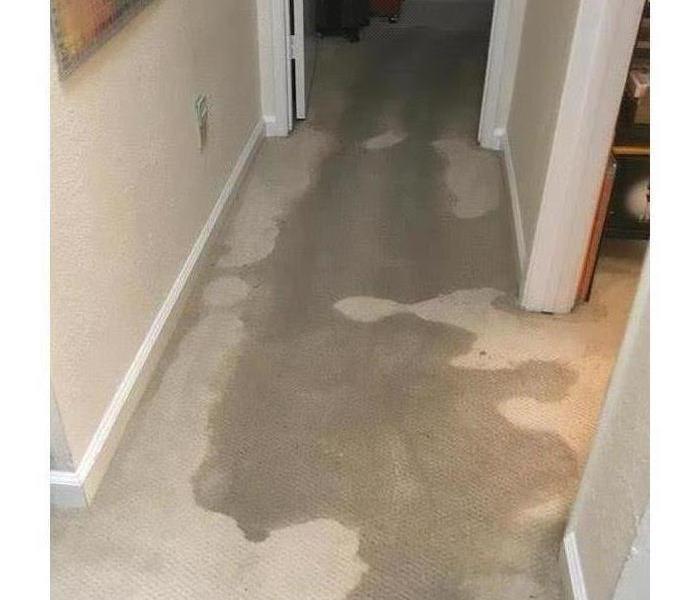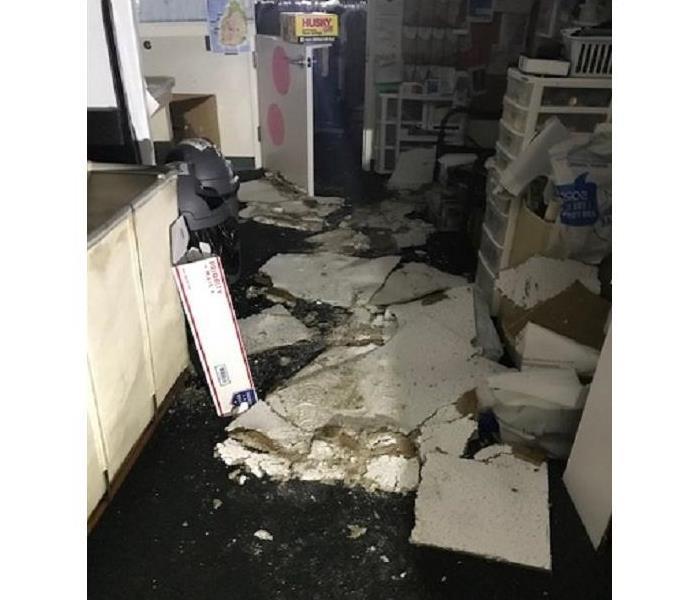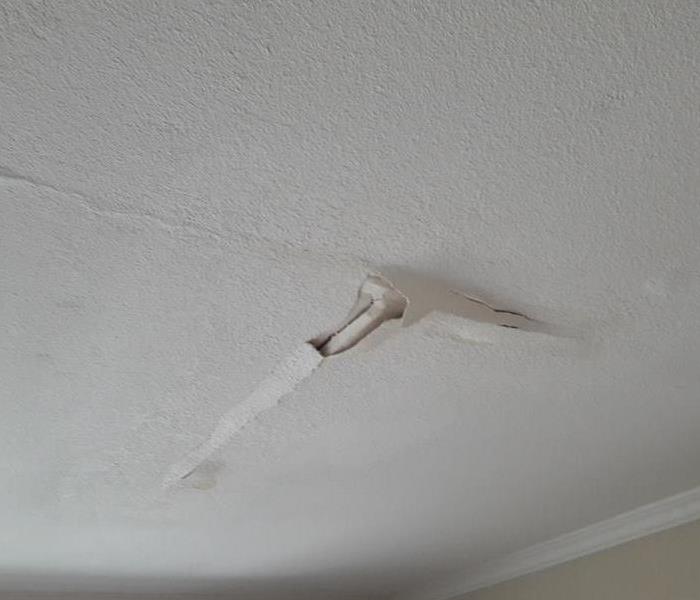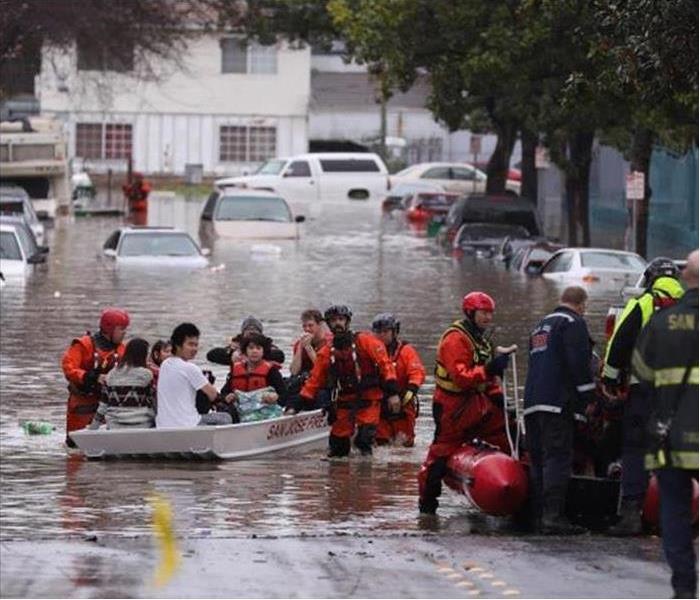Recent Water Damage Posts
Quick Response to Water Damage
6/13/2024 (Permalink)
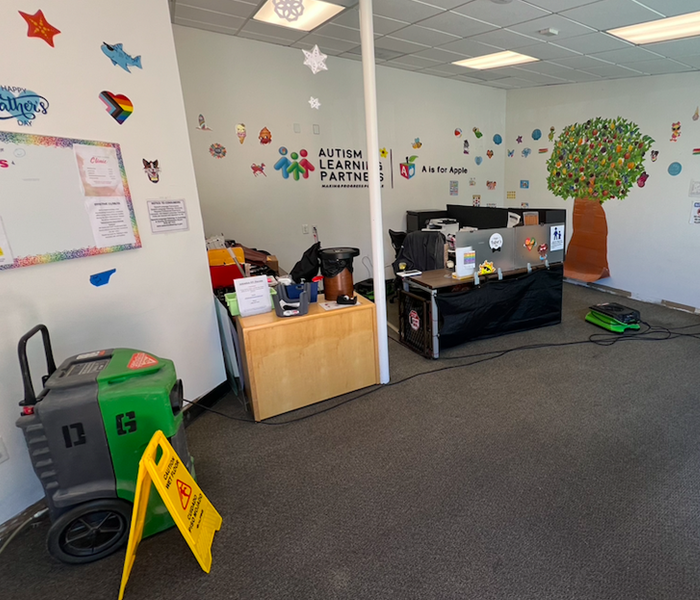 An office area with various pieces of drying equipment from SERVPRO, including a dehumidifier and air movers, set up to mitigate water damage.
An office area with various pieces of drying equipment from SERVPRO, including a dehumidifier and air movers, set up to mitigate water damage.
Last week, our team was called to address a significant water damage issue at a local facility. We are proud to share how we managed to handle the situation efficiently and effectively, ensuring minimal disruption to their operations and the children they serve.
Immediate Action and Response:
Upon receiving the call about the water damage, our team was on-site within an hour, ready to tackle the issue. Our swift response was crucial in minimizing the extent of the damage and starting the recovery process as soon as possible.
Sectioning Off Affected Areas:
Understanding the importance of maintaining a safe and operational environment for the facility, we quickly sectioned off the affected parts of the building. This strategic move allowed the facility to remain open and operational. By isolating the damaged areas, we ensured that the rest of the facility remained accessible and safe for their staff and children.
Ongoing Support and Service Continuity:
Despite the water damage, the facility's priority remained clear: to support the children and families who rely on their services. Thanks to our quick thinking and effective management, they were able to keep the facility open and continue their programs. Our commitment to providing fast and reliable service helped them maintain a stable and supportive environment for the kids.
Gratitude for Team Effort and Community Support:
We are incredibly grateful for the dedication and hard work of our team members who responded promptly and worked tirelessly to mitigate the damage. Their efforts exemplify our company's resilience and commitment to service. Additionally, we appreciate the understanding and support from the facility's community during this time. Their patience and cooperation have been invaluable as we worked through this challenge.
Moving Forward:
As we continue to support the facility in addressing the aftermath of the water damage, we remain focused on maintaining a safe and welcoming environment for everyone there. We have taken additional steps to ensure that similar incidents are prevented in the future and are continuously improving our response strategies.
Thank you for your continued trust in our services. Together, we can overcome any challenge and continue to provide the best possible care and support for the communities we serve.
Restoring Your Crawl Space After Heavy Rains: Our Process
5/2/2024 (Permalink)
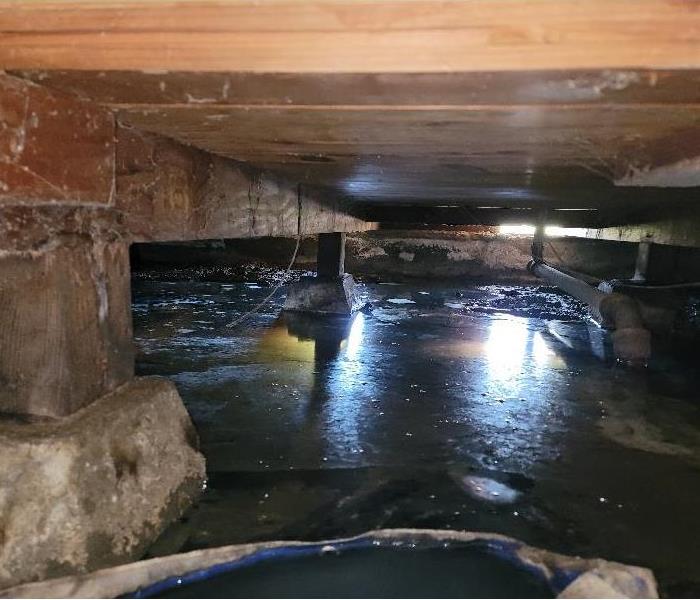 A photo depicting a crawl space with pooled water covering the ground, indicating water damage likely caused by heavy rains.
A photo depicting a crawl space with pooled water covering the ground, indicating water damage likely caused by heavy rains.
At SERVPRO of SW San Jose, we understand the stress and frustration that comes with unexpected water damage. Whether it's a burst pipe, a leaky roof, or, as in this case, heavy rains causing water to pool in your crawl space, it's crucial to address the issue promptly to prevent further damage and mold growth. In this post, we'll walk you through the steps we took to extract the water and restore a crawl space affected by recent heavy rains.
Upon arrival at the site, our team conducted a thorough assessment of the crawl space to determine the extent of the water damage. We observed standing water covering a significant portion of the area, indicating the need for immediate action to prevent structural damage and mold growth.
Using specialized equipment, we began the water extraction process. Our technicians carefully pumped out the excess water, taking care to remove as much moisture as possible to expedite the drying process. This step is crucial in preventing further damage to the crawl space's foundation and minimizing the risk of mold and mildew growth.
With the excess water removed, we implemented a comprehensive drying strategy to restore the crawl space to its pre-damage condition. We strategically placed high-powered fans throughout the area to promote airflow and accelerate the evaporation of any remaining moisture. Additionally, we utilized dehumidifiers to further reduce humidity levels, creating an environment inhospitable to mold growth.
Throughout the drying process, our team closely monitored the moisture levels in the crawl space, making adjustments to the drying equipment as needed to ensure optimal results. We understand the importance of thoroughness in water damage restoration, and we spared no effort in ensuring that the affected crawl space was fully dry.
At SERVPRO of SW San Jose, we take pride in our ability to provide effective and efficient water damage restoration services, even in the face of challenging conditions such as heavy rains. If your home has been affected by water damage, don't hesitate to contact us. Our experienced team is here to help you restore your home to its pre-damage condition quickly and effectively. Remember, addressing water damage promptly is key to preventing further complications down the line.
Water damage from a flooded in bathroom.
6/2/2023 (Permalink)
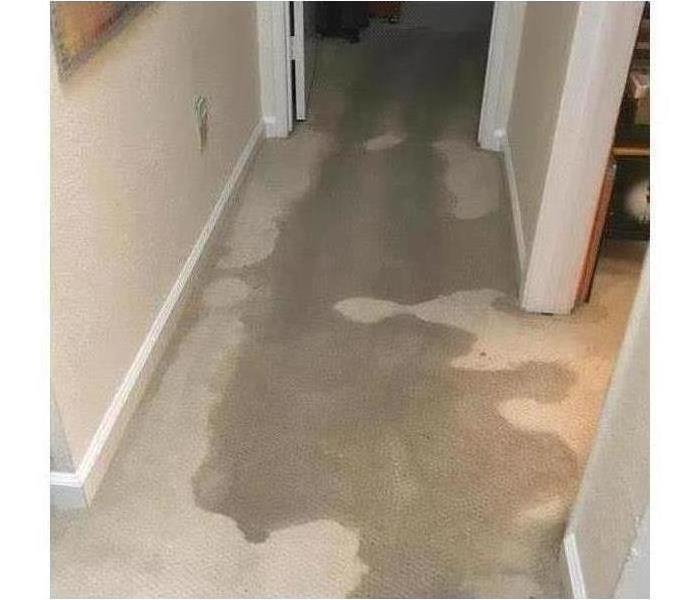 House will need a new carpet.
House will need a new carpet.
Whether due to lack of attention or a freak accident, all homeowners at one point or another experience some type of water issue in their homes. And in many cases, the problems present themselves in subtle ways. The key is to be on the lookout for them so that they don't become a matter that requires a significant amount of time, money, and effort to fix.
With this in mind, the Insurance Institute for Business and Home Safety (IBHS) chronicled the five leading causes of water damage based on property insurance claims. In addition, they outlined the potential indicators of a problem and tips on how homeowners can solve them.
1. PLUMBING SUPPLY SYSTEM FAILURE
The average cost of a plumbing supply system failure was more than $5,000 after the insurance deductible was paid, according to the IBHS study.
Ways to Reduce Damage
- Potential indicators of a plumbing problem include an increased monthly water bill, banging pipes, rust stains, and moisture in the walls or on floors, and signs of wet soil erosion near the foundation.
- Setting the thermostat 60 degrees or higher in winter months, letting faucets drip and insulating pipes are all ways to reduce the risk of frozen pipes.
- Consider installing water alarms or a whole-house automatic water shutoff system
2. TOILET FAILURE
Toilet failures in the IBHS study cost more than $5,500 per incident after the deductible was paid. One-third of all toilet failures in the study resulted from an overflowing or clogged toilet.
Ways to Reduce Damage
- After you flush, wait for the valve to completely finish refilling the tank and bowl. If an overflow looks imminent, turn off the supply valve.
- Twice a year, inspect a toilet’s components, such as the fill, supply and flush valves and the supply line.
- Consider upgrading the toilet’s supply line to a sturdier braided steel hose.
3. WATER HEATER FAILURE
The most common causes of water heater failures in the IBHS study were a slow leak or a sudden burst in the tank, followed by supply line failures. The average cost per incident was $4,444.
Ways to Reduce Damage
- Check the life expectancy and warranty for the water heater and replace accordingly.
- Proper maintenance, such as flushing sediments and inspecting the heater’s anode rod, can increase life expectancy.
- Inspect valves to ensure proper operations, and use ball valves in place of gate valves whenever possible.
4. PLUMBING DRAIN SYSTEM FAILURE
The IBHS study found more than half of plumbing system failures were the result of sewer backups. The problem was more common in southern states and on average cost $4,000 per incident after the insurance deductible was paid.
Ways to Reduce Damage
- If the home’s sewer system is connected to the city’s sewer system – a particular problem for older homes – or if you are located downhill or below street level, contact a plumbing professional to install a backflow prevention assembly into the home’s sewer system.
- Plant trees away from lateral drain lines to prevent roots from damaging piping.
- Never pour grease down the drain.
5. WASHING MACHINE FAILURE
More than half of the claims in the IBHS study were linked to washing machine hose failures. Washing machine claims in the study averaged more than $5,300 per incident after the deductible was paid.
Ways to Reduce Damage
- One burst inlet hose, and your laundry room is flooded in a matter of minutes. Replace rubber hoses every three years and consider upgrading to sturdier braided steel hoses.
- When leaving the house for an extended period of time, turn off the hot and cold water supply valve to reduce failure risks.
Nothing can completely prevent water damage incidents. But you can reduce your risk by taking some precautions.
SERVPRO is here to Help!!
5/3/2023 (Permalink)
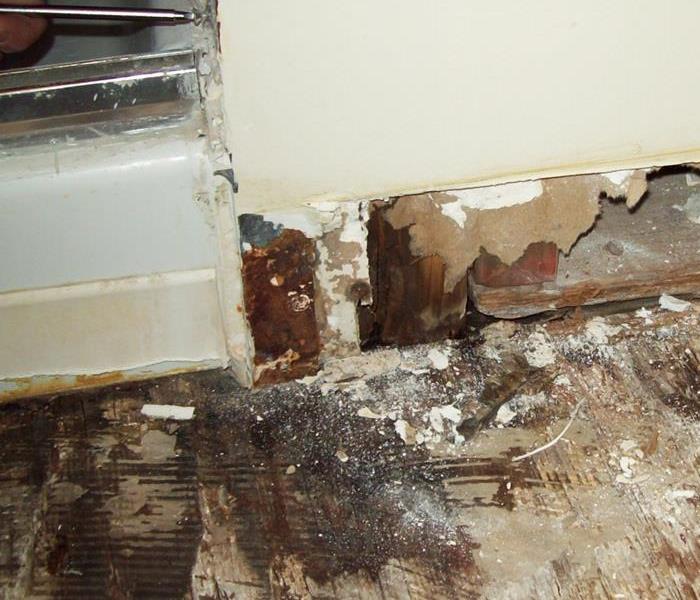 water damage needs to be taking care of soon.
water damage needs to be taking care of soon.
One of our property management clients called SERVPRO of SW San Jose because he was evicting a problem tenant who caused his apartment to become overwhelmed with roaches. The pest control company had already treated the unit on a few occasions, but now they have a serious bio-hazard cleanup on their hands.
He told us he contacted a few janitorial companies for quotes but they would not even attempt to bid the project because of the potential hazards.
SERVPRO of SW San Jose crews have the expertise and materials to handle just about any bio-hazard cleanup project. Should you run into such a situation, give SERVPRO of SW San Jose a call for your free estimate today. We will take care of the job from beginning to end. SERVPRO of SW San Jose will take care of the dirty work for you. Just call us and we will help out, and leave it "Like it never even happened."
Water damaged in San Jose, Ca
6/1/2022 (Permalink)
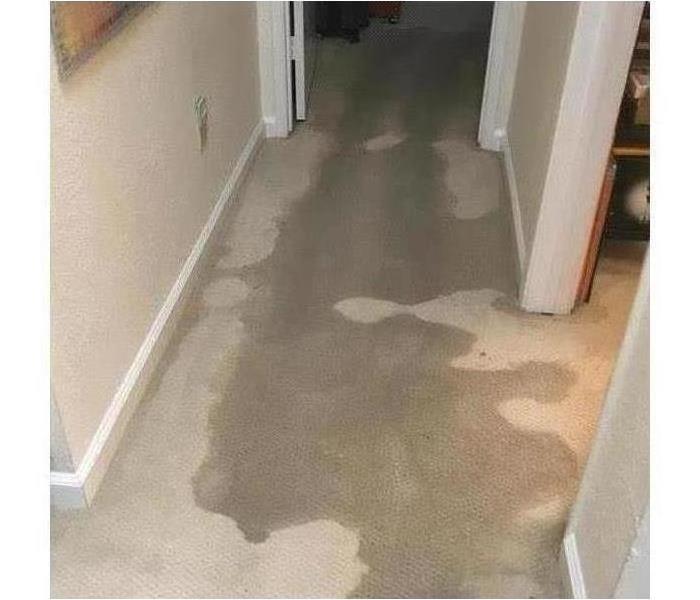 House will need a new carpet.
House will need a new carpet.
Whether due to lack of attention or a freak accident, all homeowners at one point or another experience some type of water issue in their homes. And in many cases, the problems present themselves in subtle ways. The key is to be on the lookout for them so that they don't become a matter that requires a significant amount of time, money, and effort to fix.
With this in mind, the Insurance Institute for Business and Home Safety (IBHS) chronicled the five leading causes of water damage based on property insurance claims. In addition, they outlined the potential indicators of a problem and tips on how homeowners can solve them.
1. PLUMBING SUPPLY SYSTEM FAILURE
The average cost of a plumbing supply system failure was more than $5,000 after the insurance deductible was paid, according to the IBHS study.
Ways to Reduce Damage
- Potential indicators of a plumbing problem include an increased monthly water bill, banging pipes, rust stains, and moisture in the walls or on floors, and signs of wet soil erosion near the foundation.
- Setting the thermostat 60 degrees or higher in winter months, letting faucets drip and insulating pipes are all ways to reduce the risk of frozen pipes.
- Consider installing water alarms or a whole-house automatic water shutoff system
2. TOILET FAILURE
Toilet failures in the IBHS study cost more than $5,500 per incident after the deductible was paid. One-third of all toilet failures in the study resulted from an overflowing or clogged toilet.
Ways to Reduce Damage
- After you flush, wait for the valve to completely finish refilling the tank and bowl. If an overflow looks imminent, turn off the supply valve.
- Twice a year, inspect a toilet’s components, such as the fill, supply and flush valves and the supply line.
- Consider upgrading the toilet’s supply line to a sturdier braided steel hose.
3. WATER HEATER FAILURE
The most common causes of water heater failures in the IBHS study were a slow leak or a sudden burst in the tank, followed by supply line failures. The average cost per incident was $4,444.
Ways to Reduce Damage
- Check the life expectancy and warranty for the water heater and replace accordingly.
- Proper maintenance, such as flushing sediments and inspecting the heater’s anode rod, can increase life expectancy.
- Inspect valves to ensure proper operations, and use ball valves in place of gate valves whenever possible.
4. PLUMBING DRAIN SYSTEM FAILURE
The IBHS study found more than half of plumbing system failures were the result of sewer backups. The problem was more common in southern states and on average cost $4,000 per incident after the insurance deductible was paid.
Ways to Reduce Damage
- If the home’s sewer system is connected to the city’s sewer system – a particular problem for older homes – or if you are located downhill or below street level, contact a plumbing professional to install a backflow prevention assembly into the home’s sewer system.
- Plant trees away from lateral drain lines to prevent roots from damaging piping.
- Never pour grease down the drain.
5. WASHING MACHINE FAILURE
More than half of the claims in the IBHS study were linked to washing machine hose failures. Washing machine claims in the study averaged more than $5,300 per incident after the deductible was paid.
Ways to Reduce Damage
- One burst inlet hose, and your laundry room is flooded in a matter of minutes. Replace rubber hoses every three years and consider upgrading to sturdier braided steel hoses.
- When leaving the house for an extended period of time, turn off the hot and cold water supply valve to reduce failure risks.
Nothing can completely prevent water damage incidents. But you can reduce your risk by taking some precautions.
SERVPRO is here to Help!!
5/2/2022 (Permalink)
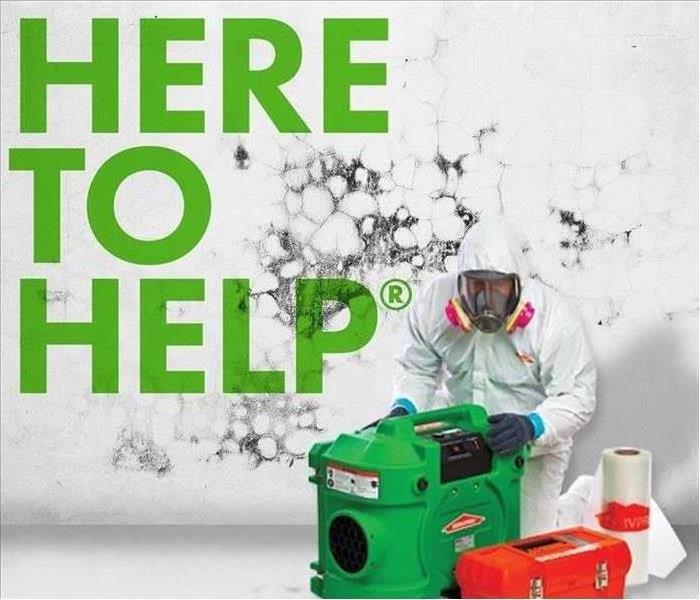 Here to help and take care of the customers.
Here to help and take care of the customers.
How do you keep clean with all that is going around with the COVID-19? Also we are here to help with an COVID-19 question you may have. Just give us a call we are to help.
Wash hands.
Avoid touching face.
Clean and sanitize home.
Clean and sanitize business.
As the #1 choice in cleanup and restoration, we can minimize the spread of germs with a proactive cleaning for your home or business.
We are here to help get back to how things were before the stay at home. We are here to clean you house or workplace. We will sanitize all of the office or home. SERVPRO of SW San Jose will also take care of any water damage, fire or mold job from beginning to end. We work in the bay area. We also will work with your home insurance or business insurance.
Give us a call today.
SERVPRO of SW San Jose 408-288-9977
Bathroom Tile Removed after Water Damage in San Jose, CA
3/30/2022 (Permalink)
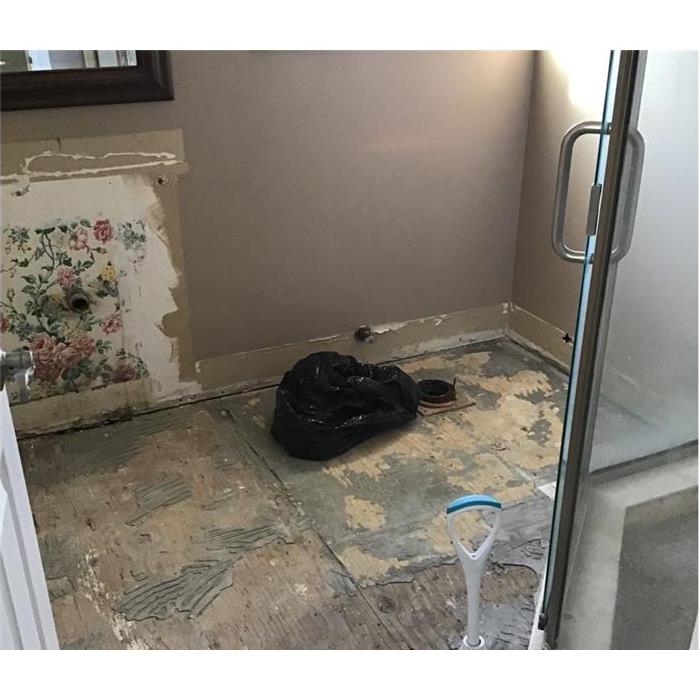 Water Damage resulted in removal of toilet and tile in upstairs bathroom.
Water Damage resulted in removal of toilet and tile in upstairs bathroom.
An upstairs toilet was leaking, causing damage to under the tile and down into bottom floor. SERVPRO of SW San Jose was called out to stop and dry the loss. Bathroom tile was removed so that the drying process could begin.
Water can weaken tile adhesives and cause your individual tiles to move about or even come free. If your tiles are moving and there's no indication of water or flooding on the floor's surface, it's definitely a warning sign of potential water damage below.
Furthermore, if you suspect a leak under your tiles, you can try tapping them with for foot or a coin. Listen for an empty or hollow sound to tell if there is separation between the tile and the baseboard.
Equipment Set Up Post Water Damage in San Jose, Ca
3/30/2022 (Permalink)
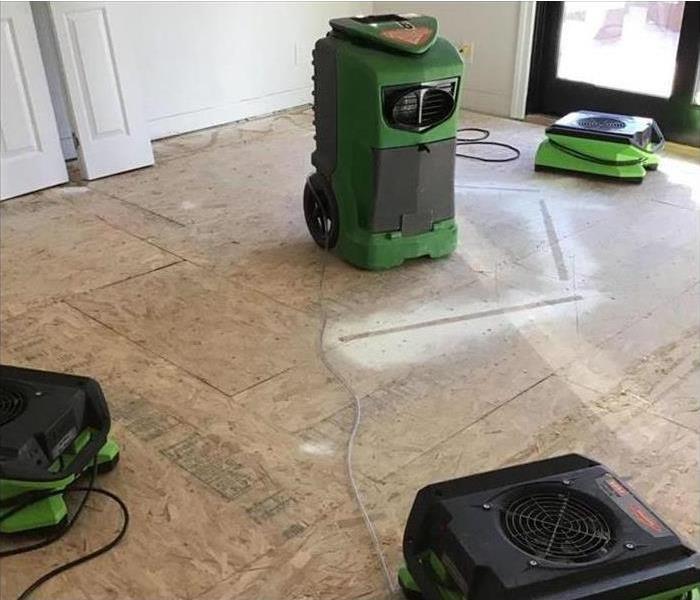 SERVPRO of SW San Jose was called out to assess a water damage. After thorough investigation the leak was discovered and fixed. Floors were pulled and
SERVPRO of SW San Jose was called out to assess a water damage. After thorough investigation the leak was discovered and fixed. Floors were pulled and
Evaluate your HVAC system’s air filter. If the filter is dirty or full, the system may not be able to function properly. A dirty air filter can restrict airflow. If the air coming out of your vents seems weak, start with a new air filter. If a clean air filter does not solve the problem, a service call might be in order.
Verify that the outdoor air conditioner unit is not covered in dirt or debris. Any type of dirt or debris that restricts the unit’s airflow can cause it to not function properly. If there is yard debris around the unit, make sure to clear it away.
Check to make sure your thermostat is set properly. At the beginning of the air conditioning season, it can be difficult to remember that your thermostat must be switched to the correct mode. If your thermostat is set incorrectly, your air conditioner will not turn on.
Schedule a tune up and maintenance appointment for your air conditioner. It’s a smart idea to have your air conditioning system tune up at least once a year. During the tune up, the system should be cleaned, lubricated and checked for any problems.
When in doubt, call your air conditioning repair company for a service call. If your air conditioning system does not seem to be working properly, make sure to call a repair company as soon as possible. Air conditioning repair companies can get very busy when the weather gets hot.
Our company handles air conditioning water damage on a routine basis during summer months. If you suspect your air conditioning system has caused water damage, please contact SERVPRO of SW San Jose.
Water damaged in San Jose, Ca
2/2/2022 (Permalink)
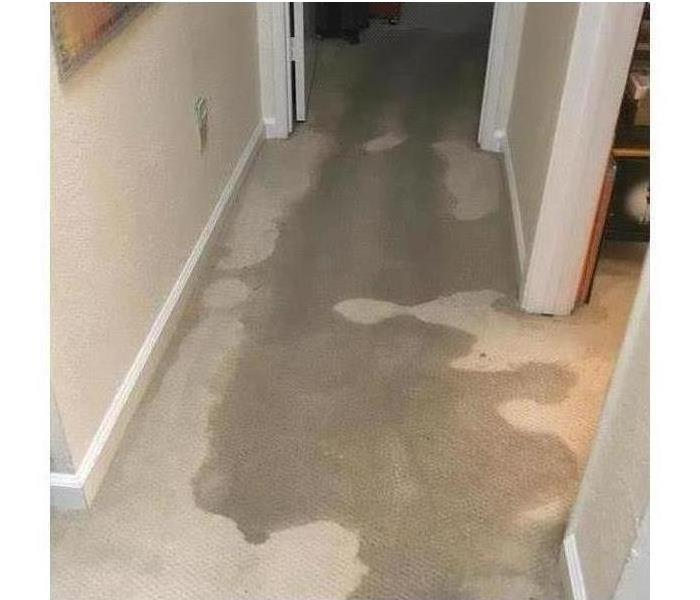 House will need a new carpet.
House will need a new carpet.
Whether due to lack of attention or a freak accident, all homeowners at one point or another experience some type of water issue in their homes. And in many cases, the problems present themselves in subtle ways. The key is to be on the lookout for them so that they don't become a matter that requires a significant amount of time, money, and effort to fix.
With this in mind, the Insurance Institute for Business and Home Safety (IBHS) chronicled the five leading causes of water damage based on property insurance claims. In addition, they outlined the potential indicators of a problem and tips on how homeowners can solve them.
1. PLUMBING SUPPLY SYSTEM FAILURE
The average cost of a plumbing supply system failure was more than $5,000 after the insurance deductible was paid, according to the IBHS study.
Ways to Reduce Damage
- Potential indicators of a plumbing problem include an increased monthly water bill, banging pipes, rust stains, and moisture in the walls or on floors, and signs of wet soil erosion near the foundation.
- Setting the thermostat 60 degrees or higher in winter months, letting faucets drip and insulating pipes are all ways to reduce the risk of frozen pipes.
- Consider installing water alarms or a whole-house automatic water shutoff system
2. TOILET FAILURE
Toilet failures in the IBHS study cost more than $5,500 per incident after the deductible was paid. One-third of all toilet failures in the study resulted from an overflowing or clogged toilet.
Ways to Reduce Damage
- After you flush, wait for the valve to completely finish refilling the tank and bowl. If an overflow looks imminent, turn off the supply valve.
- Twice a year, inspect a toilet’s components, such as the fill, supply and flush valves and the supply line.
- Consider upgrading the toilet’s supply line to a sturdier braided steel hose.
3. WATER HEATER FAILURE
The most common causes of water heater failures in the IBHS study were a slow leak or a sudden burst in the tank, followed by supply line failures. The average cost per incident was $4,444.
Ways to Reduce Damage
- Check the life expectancy and warranty for the water heater and replace accordingly.
- Proper maintenance, such as flushing sediments and inspecting the heater’s anode rod, can increase life expectancy.
- Inspect valves to ensure proper operations, and use ball valves in place of gate valves whenever possible.
4. PLUMBING DRAIN SYSTEM FAILURE
The IBHS study found more than half of plumbing system failures were the result of sewer backups. The problem was more common in southern states and on average cost $4,000 per incident after the insurance deductible was paid.
Ways to Reduce Damage
- If the home’s sewer system is connected to the city’s sewer system – a particular problem for older homes – or if you are located downhill or below street level, contact a plumbing professional to install a backflow prevention assembly into the home’s sewer system.
- Plant trees away from lateral drain lines to prevent roots from damaging piping.
- Never pour grease down the drain.
5. WASHING MACHINE FAILURE
More than half of the claims in the IBHS study were linked to washing machine hose failures. Washing machine claims in the study averaged more than $5,300 per incident after the deductible was paid.
Ways to Reduce Damage
- One burst inlet hose, and your laundry room is flooded in a matter of minutes. Replace rubber hoses every three years and consider upgrading to sturdier braided steel hoses.
- When leaving the house for an extended period of time, turn off the hot and cold water supply valve to reduce failure risks.
Nothing can completely prevent water damage incidents. But you can reduce your risk by taking some precautions.
Water damaged in a Milpitas, Ca house.
2/2/2022 (Permalink)
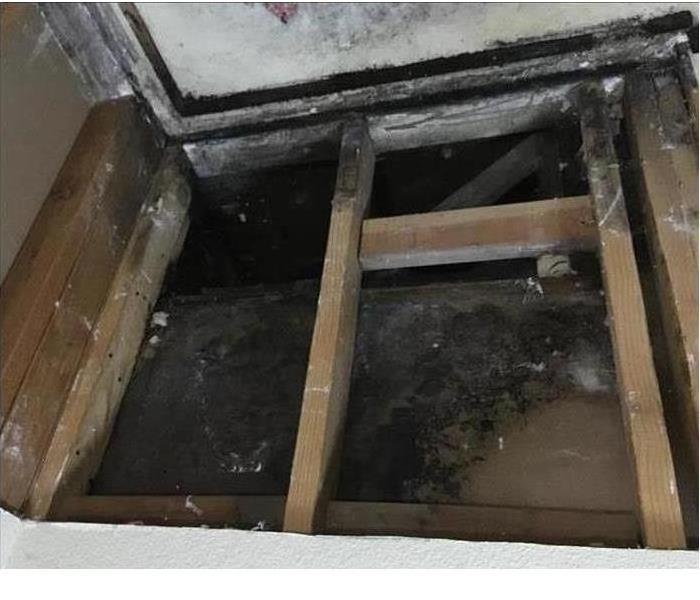 Mold inside the house due to mold.
Mold inside the house due to mold.
Unfortunately for this customer in Milpitas, CA they let a water leak go for too long. When they called SERVPRO of SW San Jose they told them they knew they had a chip in their tile grout around the bathtub but didn't fill it.
They ignored the problem and water continued to drip into the cavity.
About a year later the called SERVPRO of SW San Jose, because their wall in their adjacent hallway was bowing and showed discoloration. We performed a complementary inspection and detected water inside the wall using a moisture meter.
Once we opened the wall we found out the total extent of their damage. What could have been fixed with a tube of sealant will now cost thousands to repair.
Water damage in San Jose, Ca
5/24/2021 (Permalink)
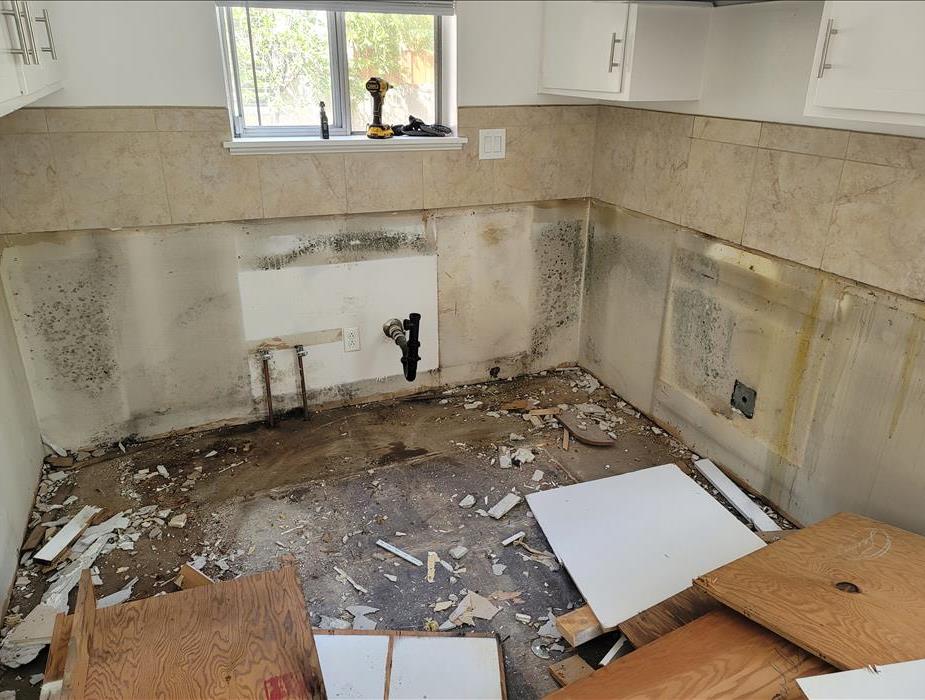 Above is a water damage that revealed multiple flooring below the initial damage.
Above is a water damage that revealed multiple flooring below the initial damage.
Last week, we got a call from a customer who noticed some discoloration in his wall. He asked for an inspection because he wasn't sure if it was water damage.
To detect water disruption, we primarily use non-intrusive moisture meters. This form of moisture meter has the advantage of causing no physical harm to the products being tested.
Our examination found that not only his wall cavity, but also a significant portion of his flooring had been damaged. Look at how we discovered another layer of tile underneath the floating floor in the frame. Customers are often stunned to discover one, two, or even three old floors under their laminate flooring. Without proper inspection from us, a flooring company could come in and possibly just add another layer to the mess.
We are Here to Help
5/1/2021 (Permalink)
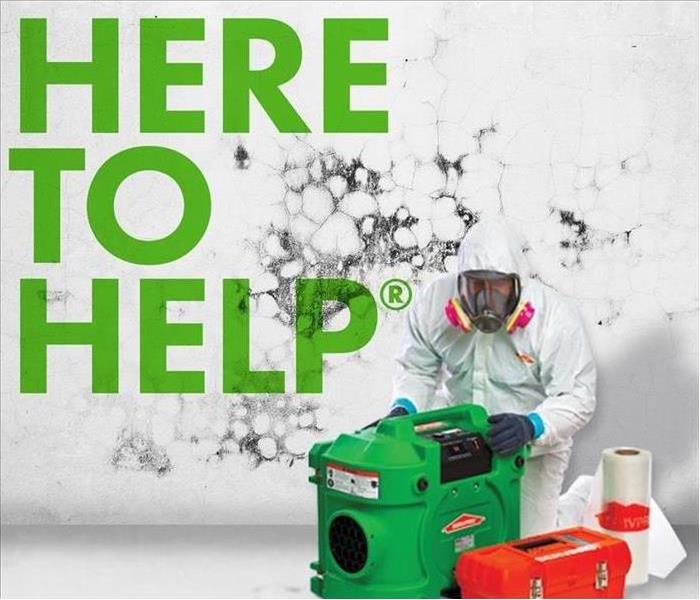 We are always here to help
We are always here to help
How do you keep clean with all that is going around with the COVID-19? Also we are here to help with an COVID-19 question you may have. Just give us a call we are to help.
Wash hands.
Avoid touching face.
Clean and sanitize home.
Clean and sanitize business.
As the #1 choice in cleanup and restoration, we can minimize the spread of germs with a proactive cleaning for your home or business.
We are here to help get back to how things were before the stay at home. We are here to clean you house or workplace. We will sanitize all of the office or home. SERVPRO of SW San Jose will also take care of any water damage, fire or mold job from beginning to end. We work in the bay area. We also will work with your home insurance or business insurance.
Give us a call today.
SERVPRO of SW San Jose 408-288-9977
How to reduce water damage to your home.
3/25/2021 (Permalink)
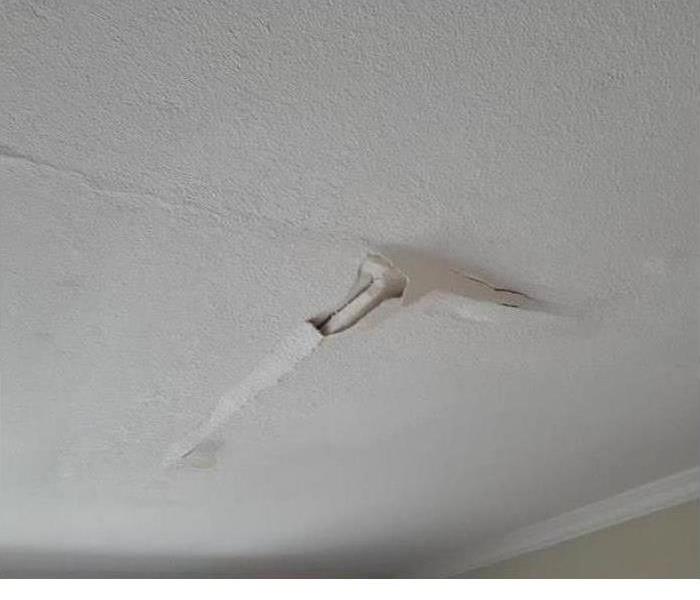 bathroom ceiling water damage
bathroom ceiling water damage
Whether due to lack of attention or a freak accident, all homeowners at one point or another experience some type of water issue in their homes. And in many cases, the problems present themselves in subtle ways. The key is to be on the lookout for them so that they don't become a matter that requires a significant amount of time, money, and effort to fix.
With this in mind, the Insurance Institute for Business and Home Safety (IBHS) chronicled the five leading causes of water damage based on property insurance claims. In addition, they outlined the potential indicators of a problem and tips on how homeowners can solve them.
1. PLUMBING SUPPLY SYSTEM FAILURE
The average cost of a plumbing supply system failure was more than $5,000 after the insurance deductible was paid, according to the IBHS study.
Ways to Reduce Damage
- Potential indicators of a plumbing problem include an increased monthly water bill, banging pipes, rust stains, and moisture in the walls or on floors, and signs of wet soil erosion near the foundation.
- Setting the thermostat 60 degrees or higher in winter months, letting faucets drip and insulating pipes are all ways to reduce the risk of frozen pipes.
- Consider installing water alarms or a whole-house automatic water shutoff system
2. TOILET FAILURE
Toilet failures in the IBHS study cost more than $5,500 per incident after the deductible was paid. One-third of all toilet failures in the study resulted from an overflowing or clogged toilet.
Ways to Reduce Damage
- After you flush, wait for the valve to completely finish refilling the tank and bowl. If an overflow looks imminent, turn off the supply valve.
- Twice a year, inspect a toilet’s components, such as the fill, supply and flush valves and the supply line.
- Consider upgrading the toilet’s supply line to a sturdier braided steel hose.
3. WATER HEATER FAILURE
The most common causes of water heater failures in the IBHS study were a slow leak or a sudden burst in the tank, followed by supply line failures. The average cost per incident was $4,444.
Ways to Reduce Damage
- Check the life expectancy and warranty for the water heater and replace accordingly.
- Proper maintenance, such as flushing sediments and inspecting the heater’s anode rod, can increase life expectancy.
- Inspect valves to ensure proper operations, and use ball valves in place of gate valves whenever possible.
4. PLUMBING DRAIN SYSTEM FAILURE
The IBHS study found more than half of plumbing system failures were the result of sewer backups. The problem was more common in southern states and on average cost $4,000 per incident after the insurance deductible was paid.
Ways to Reduce Damage
- If the home’s sewer system is connected to the city’s sewer system – a particular problem for older homes – or if you are located downhill or below street level, contact a plumbing professional to install a backflow prevention assembly into the home’s sewer system.
- Plant trees away from lateral drain lines to prevent roots from damaging piping.
- Never pour grease down the drain.
5. WASHING MACHINE FAILURE
More than half of the claims in the IBHS study were linked to washing machine hose failures. Washing machine claims in the study averaged more than $5,300 per incident after the deductible was paid.
Ways to Reduce Damage
- One burst inlet hose, and your laundry room is flooded in a matter of minutes. Replace rubber hoses every three years and consider upgrading to sturdier braided steel hoses.
- When leaving the house for an extended period of time, turn off the hot and cold water supply valve to reduce failure risks.
Nothing can completely prevent water damage incidents. But you can reduce your risk by taking some precautions.
Office in Los Gatos had a water damage.
3/25/2021 (Permalink)
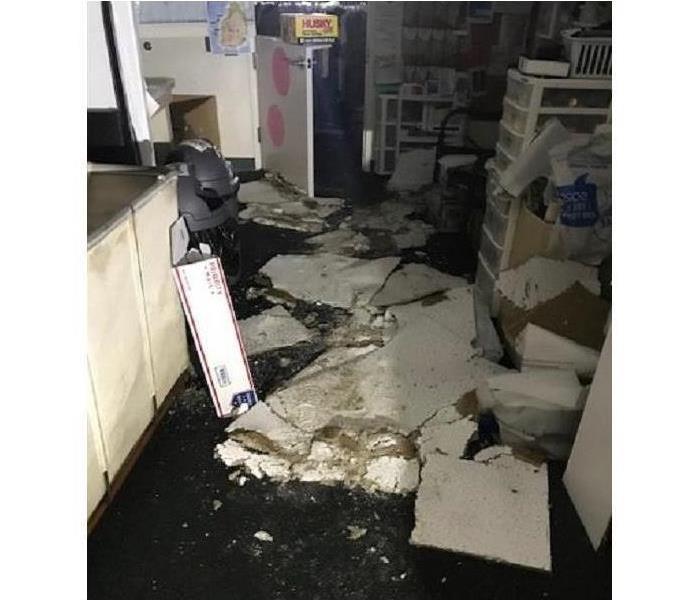 water in office upstairs affected downstairs store
water in office upstairs affected downstairs store
An office in Los Gatos, CA flooded a downstairs store over the weekend. The store manager got to the store to see water coming down from the ceiling like rain. The store manager called SERVPRO of SW San Jose to come help them take care of the water. SERVPRO was there to help and dry the upstairs and downstairs units. SERVPRO of SW San Jose also helped the upstairs tenants to move to a different store until SERVPRO fixed the unit. SERVPRO of SW San Jose was called out on a Sunday to help the store owner, to set equipment and help clean up the mess. SERVPRO was there to help and take care of all the damage that happened to the building. The owner was thrilled that we came in and helped in any way they needed help.
Water damaged from the toilet.
1/29/2021 (Permalink)
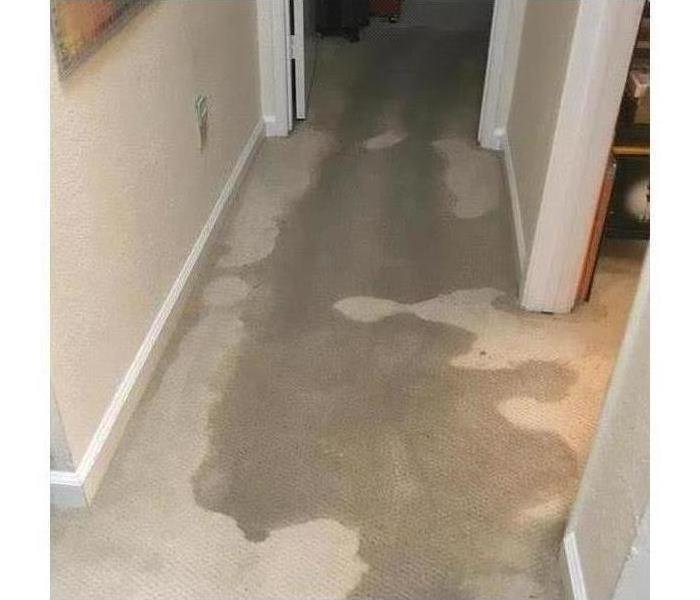 hallway carpet affected and bedroom
hallway carpet affected and bedroom
Whether due to lack of attention or a freak accident, all homeowners at one point or another experience some type of water issue in their homes. And in many cases, the problems present themselves in subtle ways. The key is to be on the lookout for them so that they don't become a matter that requires a significant amount of time, money, and effort to fix.
With this in mind, the Insurance Institute for Business and Home Safety (IBHS) chronicled the five leading causes of water damage based on property insurance claims. In addition, they outlined the potential indicators of a problem and tips on how homeowners can solve them.
1. PLUMBING SUPPLY SYSTEM FAILURE
The average cost of a plumbing supply system failure was more than $5,000 after the insurance deductible was paid, according to the IBHS study.
Ways to Reduce Damage
- Potential indicators of a plumbing problem include an increased monthly water bill, banging pipes, rust stains, and moisture in the walls or on floors, and signs of wet soil erosion near the foundation.
- Setting the thermostat 60 degrees or higher in winter months, letting faucets drip and insulating pipes are all ways to reduce the risk of frozen pipes.
- Consider installing water alarms or a whole-house automatic water shutoff system
2. TOILET FAILURE
Toilet failures in the IBHS study cost more than $5,500 per incident after the deductible was paid. One-third of all toilet failures in the study resulted from an overflowing or clogged toilet.
Ways to Reduce Damage
- After you flush, wait for the valve to completely finish refilling the tank and bowl. If an overflow looks imminent, turn off the supply valve.
- Twice a year, inspect a toilet’s components, such as the fill, supply and flush valves and the supply line.
- Consider upgrading the toilet’s supply line to a sturdier braided steel hose.
3. WATER HEATER FAILURE
The most common causes of water heater failures in the IBHS study were a slow leak or a sudden burst in the tank, followed by supply line failures. The average cost per incident was $4,444.
Ways to Reduce Damage
- Check the life expectancy and warranty for the water heater and replace accordingly.
- Proper maintenance, such as flushing sediments and inspecting the heater’s anode rod, can increase life expectancy.
- Inspect valves to ensure proper operations, and use ball valves in place of gate valves whenever possible.
4. PLUMBING DRAIN SYSTEM FAILURE
The IBHS study found more than half of plumbing system failures were the result of sewer backups. The problem was more common in southern states and on average cost $4,000 per incident after the insurance deductible was paid.
Ways to Reduce Damage
- If the home’s sewer system is connected to the city’s sewer system – a particular problem for older homes – or if you are located downhill or below street level, contact a plumbing professional to install a backflow prevention assembly into the home’s sewer system.
- Plant trees away from lateral drain lines to prevent roots from damaging piping.
- Never pour grease down the drain.
5. WASHING MACHINE FAILURE
More than half of the claims in the IBHS study were linked to washing machine hose failures. Washing machine claims in the study averaged more than $5,300 per incident after the deductible was paid.
Ways to Reduce Damage
- One burst inlet hose, and your laundry room is flooded in a matter of minutes. Replace rubber hoses every three years and consider upgrading to sturdier braided steel hoses.
- When leaving the house for an extended period of time, turn off the hot and cold water supply valve to reduce failure risks.
Nothing can completely prevent water damage incidents. But you can reduce your risk by taking some precautions.
Water damaged in Milpitas, Ca
1/29/2021 (Permalink)
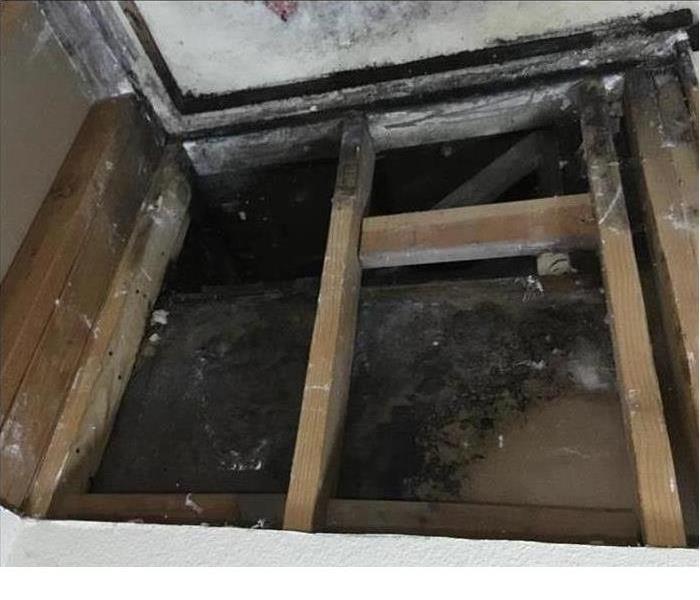 A large amount of mold grows inside this wall cavity
A large amount of mold grows inside this wall cavity
Unfortunately for this customer in Milpitas, CA they let a water leak go for too long. When they called SERVPRO of SW San Jose they told them they knew they had a chip in their tile grout around the bathtub but didn't fill it.
They ignored the problem and water continued to drip into the cavity.
About a year later the called SERVPRO of SW San Jose, because their wall in their adjacent hallway was bowing and showed discoloration. We performed a complementary inspection and detected water inside the wall using a moisture meter.
Once we opened the wall we found out the total extent of their damage. What could have been fixed with a tube of sealant will now cost thousands to repair.
Homeowner Insurance
5/7/2020 (Permalink)
 Why it is good to have homeowner insurance.
Why it is good to have homeowner insurance.
First-time homeowners are faced with many realities of being “an adult,” and one of the things that comes with owning a new home is making sure you have proper insurance. But not all insurances are the same.
Just because you have insurance on your home doesn’t mean you’re protected from everything that could happen. In fact, often with homeowner policies, there are some very common occurrences that might not be covered.
Homeowners insurance differs from state to state, so to avoid making costly assumptions, it’s important to understand what’s included with your policy.
Typically, a policy will cover the actual dwelling and some of the other structures on the property, such as a fence, garage, patio or driveway. Personal property is usually covered as well. This includes the contents inside the home, although you may need to pay a bit more in premiums for high-value items like jewelry or paintings. You’ll want to make sure this is covered in your policy.
Homeowners insurance policies typically include coverage for injuries sustained on your property where you are liable. So, if someone slips on your driveway or falls while doing repairs to the roof, you’re covered. However, this coverage is usually limited to a certain dollar value, so you need to know how much coverage you have and exactly what’s included.
Natural disasters are the one area that can cause some problems, as not everything is covered and you often have to buy separate flood, hurricane or earthquake insurance—especially if you are in an area that is highly susceptible to these disasters. You also may be able to lower premiums by better protecting yourself against damage, such as adding storm shutters, reinforcing your roof or buying stronger roofing materials.
If items are stolen from your vehicle while it sits on your property, that may or may not be covered by your insurance. Normally, this is covered by auto insurance but there are some homeowner policies that will include these items, so it’s good to know if yours will.
Many first-time buyers think they need insurance to cover the entire cost of the house, but the land under your house isn’t at risk from theft, windstorm, fire or other perils covered in your homeowners policy, so it’s not necessary to include these when deciding how much insurance you should buy. Talk with your REALTOR® and determine the best number so you have enough coverage but not too much, and that you’re not paying premiums for what you don’t need.
Water damage and cleanup
4/29/2020 (Permalink)
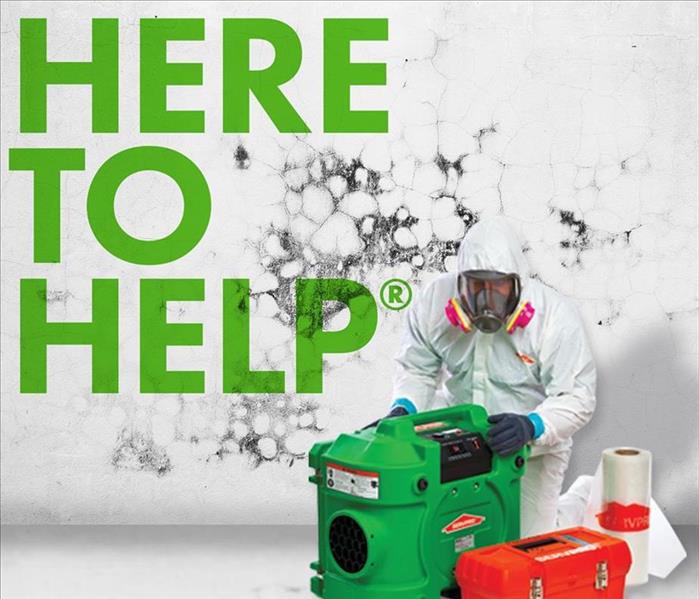 #1 choice in cleanup
#1 choice in cleanup
How do you keep clean with all that is going around with the COVID-19? Also we are here to help with an COVID-19 question you may have. Just give us a call we are to help.
Wash hands.
Avoid touching face.
Clean and sanitize home.
Clean and sanitize business.
As the #1 choice in cleanup and restoration, we can minimize the spread of germs with a proactive cleaning for your home or business.
We are here to help get back to how things were before the stay at home. We are here to clean you house or workplace. We will sanitize all of the office or home. SERVPRO of SW San Jose will also take care of any water damage, fire or mold job from beginning to end. We work in the bay area. We also will work with your home insurance or business insurance.
Give us a call today.
SERVPRO of SW San Jose 408-288-9977
March Madness 2020
3/6/2020 (Permalink)
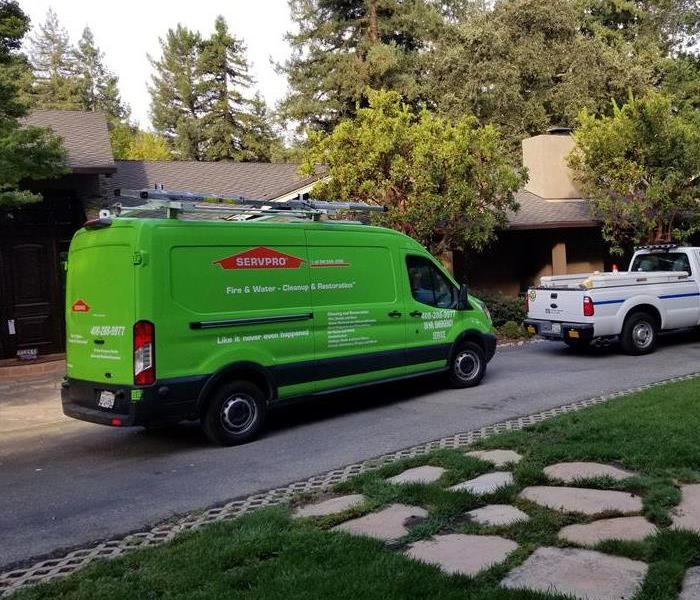 SERVPRO is here to help
SERVPRO is here to help
It's that time of year again, time for March Madness!
Grand Prize: 2 tickets to your choice of the Sharks, 49ers, Giants, A’s, Warriors, or Earthquakes
2nd Prize: $75 Gift Card to your choice of The Cheesecake Factory
3rd Prize: $25 Starbucks or Peet’s Coffee Gift Card
Consolation Prize: 4th place and up receive $5 Starbucks or Peet’s Card
Eligibility: Must be a SERVPRO of SW San Jose Partner (owner, agent, agent staff, property mgr, realtor, broker, or employee).
How to Enter: Visit: http://SERVPROswsj.mayhem.cbssports.com. If you wish, you may have the computer choose your bracket for you – no basketball knowledge or experience required! J
ENTRIES MUST BE COMPLETED BY THE TOURNAMENT 9AM PST 3/15/2020. THERE IS NO COST OR OBLIGATION TO ENTER. One entry per person. Contest rules are listed on the website.
Good luck from your Fire, Water, and Mold Cleanup & Restoration Experts…… SERVPRO OF SOUTHWEST SAN JOSE!!
Ways to reduce water damage!!
3/6/2020 (Permalink)
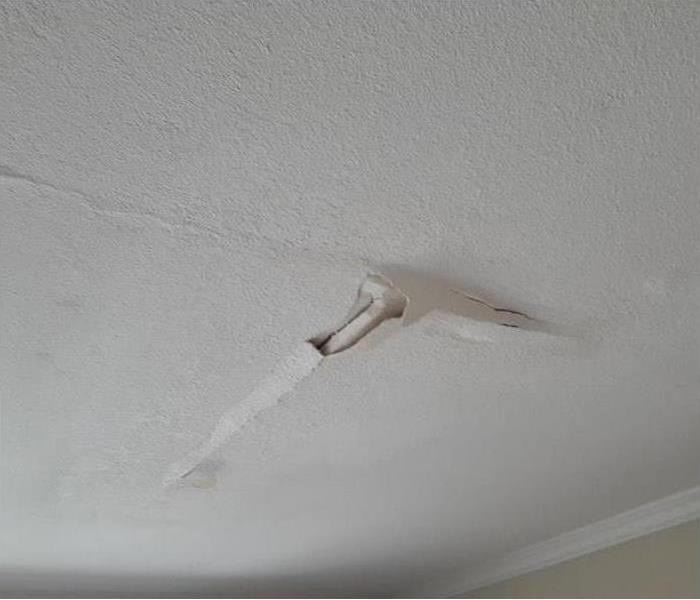 bathroom ceiling water damage
bathroom ceiling water damage
Whether due to lack of attention or a freak accident, all homeowners at one point or another experience some type of water issue in their homes. And in many cases, the problems present themselves in subtle ways. The key is to be on the lookout for them so that they don't become a matter that requires a significant amount of time, money, and effort to fix.
With this in mind, the Insurance Institute for Business and Home Safety (IBHS) chronicled the five leading causes of water damage based on property insurance claims. In addition, they outlined the potential indicators of a problem and tips on how homeowners can solve them.
1. PLUMBING SUPPLY SYSTEM FAILURE
The average cost of a plumbing supply system failure was more than $5,000 after the insurance deductible was paid, according to the IBHS study.
Ways to Reduce Damage
- Potential indicators of a plumbing problem include an increased monthly water bill, banging pipes, rust stains, and moisture in the walls or on floors, and signs of wet soil erosion near the foundation.
- Setting the thermostat 60 degrees or higher in winter months, letting faucets drip and insulating pipes are all ways to reduce the risk of frozen pipes.
- Consider installing water alarms or a whole-house automatic water shutoff system
2. TOILET FAILURE
Toilet failures in the IBHS study cost more than $5,500 per incident after the deductible was paid. One-third of all toilet failures in the study resulted from an overflowing or clogged toilet.
Ways to Reduce Damage
- After you flush, wait for the valve to completely finish refilling the tank and bowl. If an overflow looks imminent, turn off the supply valve.
- Twice a year, inspect a toilet’s components, such as the fill, supply and flush valves and the supply line.
- Consider upgrading the toilet’s supply line to a sturdier braided steel hose.
3. WATER HEATER FAILURE
The most common causes of water heater failures in the IBHS study were a slow leak or a sudden burst in the tank, followed by supply line failures. The average cost per incident was $4,444.
Ways to Reduce Damage
- Check the life expectancy and warranty for the water heater and replace accordingly.
- Proper maintenance, such as flushing sediments and inspecting the heater’s anode rod, can increase life expectancy.
- Inspect valves to ensure proper operations, and use ball valves in place of gate valves whenever possible.
4. PLUMBING DRAIN SYSTEM FAILURE
The IBHS study found more than half of plumbing system failures were the result of sewer backups. The problem was more common in southern states and on average cost $4,000 per incident after the insurance deductible was paid.
Ways to Reduce Damage
- If the home’s sewer system is connected to the city’s sewer system – a particular problem for older homes – or if you are located downhill or below street level, contact a plumbing professional to install a backflow prevention assembly into the home’s sewer system.
- Plant trees away from lateral drain lines to prevent roots from damaging piping.
- Never pour grease down the drain.
5. WASHING MACHINE FAILURE
More than half of the claims in the IBHS study were linked to washing machine hose failures. Washing machine claims in the study averaged more than $5,300 per incident after the deductible was paid.
Ways to Reduce Damage
- One burst inlet hose, and your laundry room is flooded in a matter of minutes. Replace rubber hoses every three years and consider upgrading to sturdier braided steel hoses.
- When leaving the house for an extended period of time, turn off the hot and cold water supply valve to reduce failure risks.
Nothing can completely prevent water damage incidents. But you can reduce your risk by taking some precautions.
Apartment water damage in San Jose, Ca
1/15/2020 (Permalink)
Whether due to lack of attention or a freak accident, all homeowners at one point or another experience some type of water issue in their homes. And in many cases, the problems present themselves in subtle ways. The key is to be on the lookout for them so that they don't become a matter that requires a significant amount of time, money, and effort to fix.
With this in mind, the Insurance Institute for Business and Home Safety (IBHS) chronicled the five leading causes of water damage based on property insurance claims. In addition, they outlined the potential indicators of a problem and tips on how homeowners can solve them.
1. PLUMBING SUPPLY SYSTEM FAILURE
The average cost of a plumbing supply system failure was more than $5,000 after the insurance deductible was paid, according to the IBHS study.
Ways to Reduce Damage
- Potential indicators of a plumbing problem include an increased monthly water bill, banging pipes, rust stains, and moisture in the walls or on floors, and signs of wet soil erosion near the foundation.
- Setting the thermostat 60 degrees or higher in winter months, letting faucets drip and insulating pipes are all ways to reduce the risk of frozen pipes.
- Consider installing water alarms or a whole-house automatic water shutoff system
2. TOILET FAILURE
Toilet failures in the IBHS study cost more than $5,500 per incident after the deductible was paid. One-third of all toilet failures in the study resulted from an overflowing or clogged toilet.
Ways to Reduce Damage
- After you flush, wait for the valve to completely finish refilling the tank and bowl. If an overflow looks imminent, turn off the supply valve.
- Twice a year, inspect a toilet’s components, such as the fill, supply and flush valves and the supply line.
- Consider upgrading the toilet’s supply line to a sturdier braided steel hose.
3. WATER HEATER FAILURE
The most common causes of water heater failures in the IBHS study were a slow leak or a sudden burst in the tank, followed by supply line failures. The average cost per incident was $4,444.
Ways to Reduce Damage
- Check the life expectancy and warranty for the water heater and replace accordingly.
- Proper maintenance, such as flushing sediments and inspecting the heater’s anode rod, can increase life expectancy.
- Inspect valves to ensure proper operations, and use ball valves in place of gate valves whenever possible.
4. PLUMBING DRAIN SYSTEM FAILURE
The IBHS study found more than half of plumbing system failures were the result of sewer backups. The problem was more common in southern states and on average cost $4,000 per incident after the insurance deductible was paid.
Ways to Reduce Damage
- If the home’s sewer system is connected to the city’s sewer system – a particular problem for older homes – or if you are located downhill or below street level, contact a plumbing professional to install a backflow prevention assembly into the home’s sewer system.
- Plant trees away from lateral drain lines to prevent roots from damaging piping.
- Never pour grease down the drain.
5. WASHING MACHINE FAILURE
More than half of the claims in the IBHS study were linked to washing machine hose failures. Washing machine claims in the study averaged more than $5,300 per incident after the deductible was paid.
Ways to Reduce Damage
- One burst inlet hose, and your laundry room is flooded in a matter of minutes. Replace rubber hoses every three years and consider upgrading to sturdier braided steel hoses.
- When leaving the house for an extended period of time, turn off the hot and cold water supply valve to reduce failure risks.
Nothing can completely prevent water damage incidents. But you can reduce your risk by taking some precautions.
Water damage in Milpitas, Ca
1/8/2020 (Permalink)
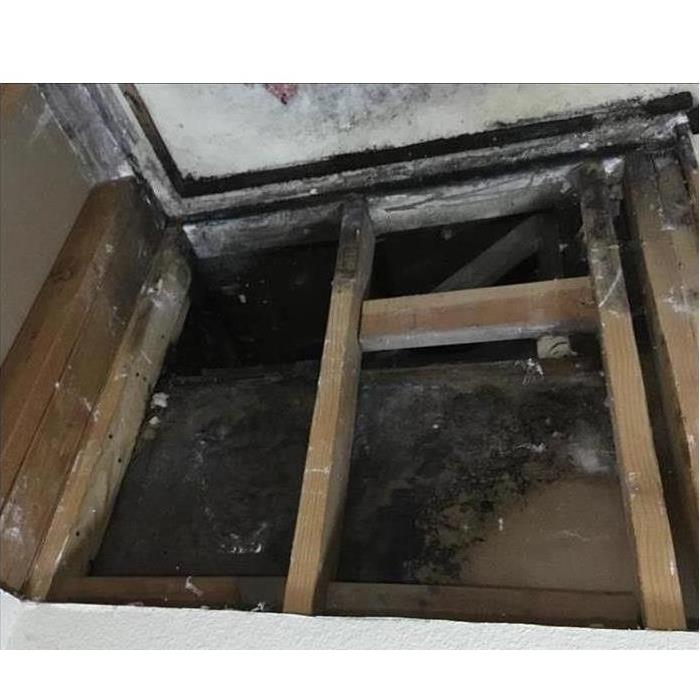 A large amount of mold grows inside this wall cavity
A large amount of mold grows inside this wall cavity
Unfortunately for this customer in Milpitas, CA they let a water leak go for too long. When they called SERVPRO of SW San Jose they told them they knew they had a chip in their tile grout around the bathtub but didn't fill it.
They ignored the problem and water continued to drip into the cavity.
About a year later the called SERVPRO of SW San Jose, because their wall in their adjacent hallway was bowing and showed discoloration. We performed a complementary inspection and detected water inside the wall using a moisture meter.
Once we opened the wall we found out the total extent of their damage. What could have been fixed with a tube of sealant will now cost thousands to repair.
Office Flooded in Downtown Los Gatos, Ca
5/15/2019 (Permalink)
An office in Los Gatos, CA flooded a downstair's store over the weekend. The store manager got to the store to see water coming down from the ceiling like rain. The store manager called SERVPRO of SW San Jose to come help them take care of the water. SERVPRO was there to help and dry the upstairs and downstairs units. SERVPRO of SW San Jose also helped the upstairs tenants to move to a different store until SERVPRO fixed the unit. SERVPRO of SW San Jose was called out on a Sunday to help the store owner, to set equipment and help clean up the mess. SERVPRO was there to help and take care of all the damage that happened to the building. The owner was thrilled that we came in and helped in anyway they needed help.
Understanding Homeowners Insurance
5/1/2019 (Permalink)
First-time homeowners are faced with many realities of being “an adult,” and one of the things that comes with owning a new home is making sure you have proper insurance. But not all insurances are the same.
Just because you have insurance on your home doesn’t mean you’re protected from everything that could happen. In fact, often with homeowner policies, there are some very common occurrences that might not be covered.
Homeowners insurance differs from state to state, so to avoid making costly assumptions, it’s important to understand what’s included with your policy.
Typically, a policy will cover the actual dwelling and some of the other structures on the property, such as a fence, garage, patio or driveway. Personal property is usually covered as well. This includes the contents inside the home, although you may need to pay a bit more in premiums for high-value items like jewelry or paintings. You’ll want to make sure this is covered in your policy.
Homeowners insurance policies typically include coverage for injuries sustained on your property where you are liable. So, if someone slips on your driveway or falls while doing repairs to the roof, you’re covered. However, this coverage is usually limited to a certain dollar value, so you need to know how much coverage you have and exactly what’s included.
Natural disasters are the one area that can cause some problems, as not everything is covered and you often have to buy separate flood, hurricane or earthquake insurance—especially if you are in an area that is highly susceptible to these disasters. You also may be able to lower premiums by better protecting yourself against damage, such as adding storm shutters, reinforcing your roof or buying stronger roofing materials.
If items are stolen from your vehicle while it sits on your property, that may or may not be covered by your insurance. Normally, this is covered by auto insurance but there are some homeowner policies that will include these items, so it’s good to know if yours will.
Many first-time buyers think they need insurance to cover the entire cost of the house, but the land under your house isn’t at risk from theft, windstorm, fire or other perils covered in your homeowners policy, so it’s not necessary to include these when deciding how much insurance you should buy. Talk with your REALTOR® and determine the best number so you have enough coverage but not too much, and that you’re not paying premiums for what you don’t need.
NCAA March Madness 2019 is here!
3/5/2019 (Permalink)
It's that time of year again, time for March Madness!
Grand Prize: 2 tickets to your choice of the Sharks, 49ers, Raiders, Giants, A’s, Warriors, or Earthquakes
2nd Prize: $75 Gift Card to your choice of The Cheesecake Factory
3rd Prize: $25 Starbucks or Peet’s Coffee Gift Card
Consolation Prize: 4th place and up receive $5 Starbucks or Peet’s Card
Eligibility: Must be a SERVPRO of SW San Jose Partner (owner, agent, agent staff, property mgr, realtor, broker, or employee).
How to Enter: Visit: http://SERVPROswsj.mayhem.cbssports.com. If you wish, you may have the computer choose your bracket for you – no basketball knowledge or experience required! J
ENTRIES MUST BE COMPLETED BY THE TOURNAMENT 9AM PST 3/1/16. THERE IS NO COST OR OBLIGATION TO ENTER. One entry per person. Contest rules are listed on the website.
Good luck from your Fire, Water, and Mold Cleanup & Restoration Experts…… SERVPRO OF SOUTHWEST SAN JOSE!!
Ways to reduce water damage!
3/5/2019 (Permalink)
Whether due to lack of attention or a freak accident, all homeowners at one point or another experience some type of water issue in their homes. And in many cases, the problems present themselves in subtle ways. The key is to be on the lookout for them so that they don't become a matter that requires a significant amount of time, money, and effort to fix.
With this in mind, the Insurance Institute for Business and Home Safety (IBHS) chronicled the five leading causes of water damage based on property insurance claims. In addition, they outlined the potential indicators of a problem and tips on how homeowners can solve them.
1. PLUMBING SUPPLY SYSTEM FAILURE
The average cost of a plumbing supply system failure was more than $5,000 after the insurance deductible was paid, according to the IBHS study.
Ways to Reduce Damage
- Potential indicators of a plumbing problem include an increased monthly water bill, banging pipes, rust stains, and moisture in the walls or on floors, and signs of wet soil erosion near the foundation.
- Setting the thermostat 60 degrees or higher in winter months, letting faucets drip and insulating pipes are all ways to reduce the risk of frozen pipes.
- Consider installing water alarms or a whole-house automatic water shutoff system
2. TOILET FAILURE
Toilet failures in the IBHS study cost more than $5,500 per incident after the deductible was paid. One-third of all toilet failures in the study resulted from an overflowing or clogged toilet.
Ways to Reduce Damage
- After you flush, wait for the valve to completely finish refilling the tank and bowl. If an overflow looks imminent, turn off the supply valve.
- Twice a year, inspect a toilet’s components, such as the fill, supply and flush valves and the supply line.
- Consider upgrading the toilet’s supply line to a sturdier braided steel hose.
3. WATER HEATER FAILURE
The most common causes of water heater failures in the IBHS study were a slow leak or a sudden burst in the tank, followed by supply line failures. The average cost per incident was $4,444.
Ways to Reduce Damage
- Check the life expectancy and warranty for the water heater and replace accordingly.
- Proper maintenance, such as flushing sediments and inspecting the heater’s anode rod, can increase life expectancy.
- Inspect valves to ensure proper operations, and use ball valves in place of gate valves whenever possible.
4. PLUMBING DRAIN SYSTEM FAILURE
The IBHS study found more than half of plumbing system failures were the result of sewer backups. The problem was more common in southern states and on average cost $4,000 per incident after the insurance deductible was paid.
Ways to Reduce Damage
- If the home’s sewer system is connected to the city’s sewer system – a particular problem for older homes – or if you are located downhill or below street level, contact a plumbing professional to install a backflow prevention assembly into the home’s sewer system.
- Plant trees away from lateral drain lines to prevent roots from damaging piping.
- Never pour grease down the drain.
5. WASHING MACHINE FAILURE
More than half of the claims in the IBHS study were linked to washing machine hose failures. Washing machine claims in the study averaged more than $5,300 per incident after the deductible was paid.
Ways to Reduce Damage
- One burst inlet hose, and your laundry room is flooded in a matter of minutes. Replace rubber hoses every three years and consider upgrading to sturdier braided steel hoses.
- When leaving the house for an extended period of time, turn off the hot and cold water supply valve to reduce failure risks.
Nothing can completely prevent water damage incidents. But you can reduce your risk by taking some precautions.
Reduce Water Damage
1/15/2019 (Permalink)
Whether due to lack of attention or a freak accident, all homeowners at one point or another experience some type of water issue in their homes. And in many cases, the problems present themselves in subtle ways. The key is to be on the lookout for them so that they don't become a matter that requires a significant amount of time, money, and effort to fix.
With this in mind, the Insurance Institute for Business and Home Safety (IBHS) chronicled the five leading causes of water damage based on property insurance claims. In addition, they outlined the potential indicators of a problem and tips on how homeowners can solve them.
1. PLUMBING SUPPLY SYSTEM FAILURE
The average cost of a plumbing supply system failure was more than $5,000 after the insurance deductible was paid, according to the IBHS study.
Ways to Reduce Damage
- Potential indicators of a plumbing problem include an increased monthly water bill, banging pipes, rust stains, and moisture in the walls or on floors, and signs of wet soil erosion near the foundation.
- Setting the thermostat 60 degrees or higher in winter months, letting faucets drip and insulating pipes are all ways to reduce the risk of frozen pipes.
- Consider installing water alarms or a whole-house automatic water shutoff system
2. TOILET FAILURE
Toilet failures in the IBHS study cost more than $5,500 per incident after the deductible was paid. One-third of all toilet failures in the study resulted from an overflowing or clogged toilet.
Ways to Reduce Damage
- After you flush, wait for the valve to completely finish refilling the tank and bowl. If an overflow looks imminent, turn off the supply valve.
- Twice a year, inspect a toilet’s components, such as the fill, supply and flush valves and the supply line.
- Consider upgrading the toilet’s supply line to a sturdier braided steel hose.
3. WATER HEATER FAILURE
The most common causes of water heater failures in the IBHS study were a slow leak or a sudden burst in the tank, followed by supply line failures. The average cost per incident was $4,444.
Ways to Reduce Damage
- Check the life expectancy and warranty for the water heater and replace accordingly.
- Proper maintenance, such as flushing sediments and inspecting the heater’s anode rod, can increase life expectancy.
- Inspect valves to ensure proper operations, and use ball valves in place of gate valves whenever possible.
4. PLUMBING DRAIN SYSTEM FAILURE
The IBHS study found more than half of plumbing system failures were the result of sewer backups. The problem was more common in southern states and on average cost $4,000 per incident after the insurance deductible was paid.
Ways to Reduce Damage
- If the home’s sewer system is connected to the city’s sewer system – a particular problem for older homes – or if you are located downhill or below street level, contact a plumbing professional to install a backflow prevention assembly into the home’s sewer system.
- Plant trees away from lateral drain lines to prevent roots from damaging piping.
- Never pour grease down the drain.
5. WASHING MACHINE FAILURE
More than half of the claims in the IBHS study were linked to washing machine hose failures. Washing machine claims in the study averaged more than $5,300 per incident after the deductible was paid.
Ways to Reduce Damage
- One burst inlet hose, and your laundry room is flooded in a matter of minutes. Replace rubber hoses every three years and consider upgrading to sturdier braided steel hoses.
- When leaving the house for an extended period of time, turn off the hot and cold water supply valve to reduce failure risks.
Nothing can completely prevent water damage incidents. But you can reduce your risk by taking some precautions.
Water damaged from an AC in San Jose, Ca
1/2/2019 (Permalink)
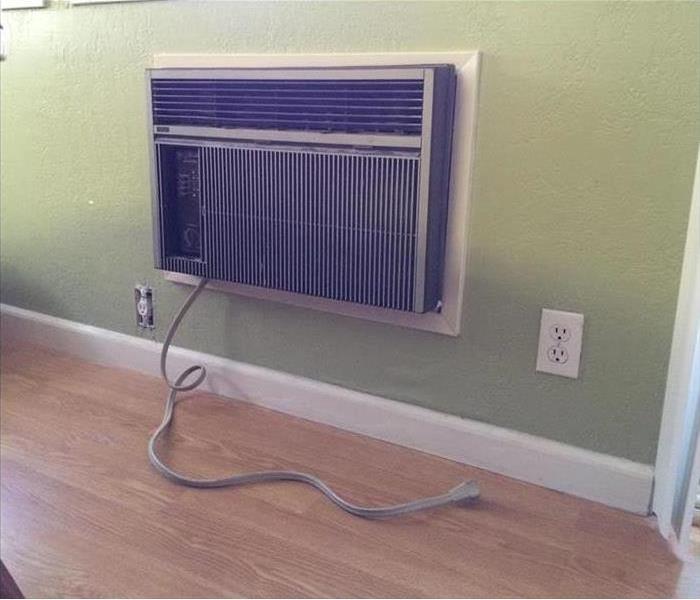 We can help clean up the water damaged.
We can help clean up the water damaged.
Troubleshooting tips for your air conditioning system:
Evaluate your HVAC system’s air filter. If the filter is dirty or full, the system may not be able to function properly. A dirty air filter can restrict airflow. If the air coming out of your vents seems weak, start with a new air filter. If a clean air filter does not solve the problem, a service call might be in order.
Verify that the outdoor air conditioner unit is not covered in dirt or debris. Any type of dirt or debris that restricts the unit’s airflow can cause it to not function properly. If there is yard debris around the unit, make sure to clear it away.
Check to make sure your thermostat is set properly. At the beginning of the air conditioning season, it can be difficult to remember that your thermostat must be switched to the correct mode. If your thermostat is set incorrectly, your air conditioner will not turn on.
Schedule a tune up and maintenance appointment for your air conditioner. It’s a smart idea to have your air conditioning system tune up at least once a year. During the tune up, the system should be cleaned, lubricated and checked for any problems.
When in doubt, call your air conditioning repair company for a service call. If your air conditioning system does not seem to be working properly, make sure to call a repair company as soon as possible. Air conditioning repair companies can get very busy when the weather gets hot.
Our company handles air conditioning water damage on a routine basis during summer months. If you suspect your air conditioning system has caused water damage, please contact SERVPRO of SW San Jose for a free evaluation.
Bathroom leak in Los Gatos, Ca
9/28/2018 (Permalink)
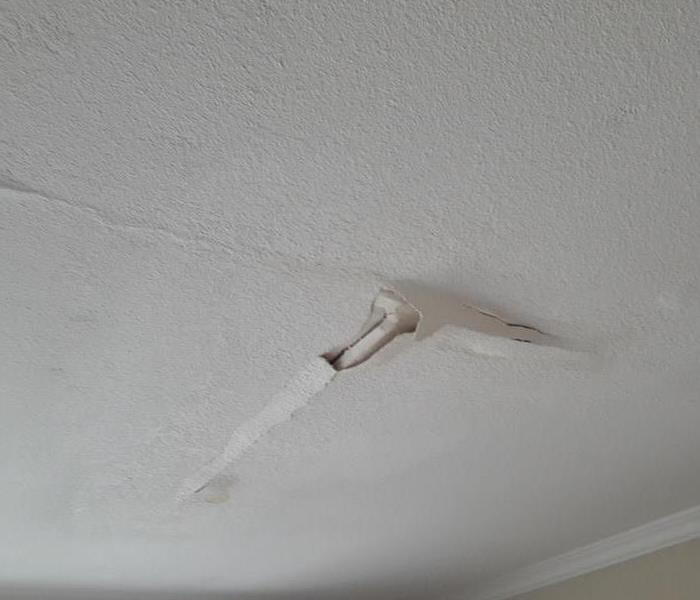 Ceiling downstairs.
Ceiling downstairs.
Working to help a customer in Los Gatos deal with a leaking wax ring from a toilet. They saw a gradual widening of discoloration in a ring pattern in the vinyl up their upstairs bathroom - then one day this nasty spot appeared on their hallway ceiling below! Luckily for them the amount of sewage was small and we were able to catch it in the initial stages. We performed their water damage cleanup and sanitized the affected areas.
Customers often ask us if there is anything they can do to help prevent this type of damage. The best advice in this instance would have been to investigate the vinyl discoloration in the upstairs bathroom at the very beginning. Frequent inspections are often a good way to prevent leaks.
A Discovery Store flood In Los Gatos
5/15/2018 (Permalink)
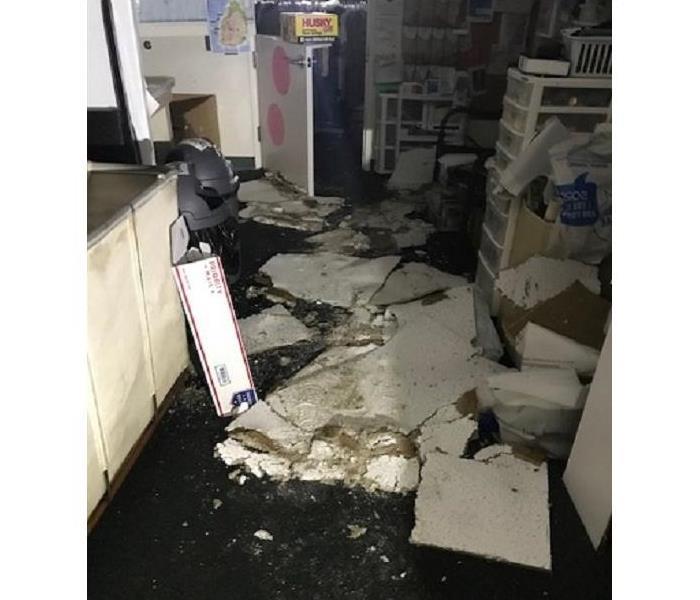 Stores ceiling on the floor
Stores ceiling on the floor
An office in Los Gatos, Ca flooded an downstairs store over the weekend. The store manager got to the store to see water coming down from the ceilling like rained. Store manager called SERVPRO of SW San Jose to come help them take care of the water. SERVPRO was there to help and dry up the upstairs and downstairs units. SERVPRO of SW San Jose also helped the upstairs tenants to move to a different store till SERVPRO fixed the unit. SERVPRO of SW San Jose was called out on a Sunday, SERVPRO was out on a Sunday to help the store owner to set equipment and help clean up the mess. SERVPRO was there to help and take care of all the damaged that happen to the building. The owner was thrilled that we came in and helped in anything they needed help.
March Madness 2018
3/5/2018 (Permalink)
 Good Luck!!!!
Good Luck!!!!
It's that time of year again, time for March Madness!
Grand Prize: 2 tickets to your choice of the Sharks, 49ers, Raiders, Giants, A’s, Warriors, or Earthquakes
2nd Prize: $75 Gift Card to your choice of The Cheesecake Factory
3rd Prize: $25 Starbucks or Peet’s Coffee Gift Card
Consolation Prize: 4th place and up receive $5 Starbucks or Peet’s Card
Eligibility: Must be a SERVPRO of SW San Jose Partner (owner, agent, agent staff, property mgr, realtor, broker, or employee).
How to Enter: Visit: http://SERVPROswsj.mayhem.cbssports.com. If you wish, you may have the computer choose your bracket for you – no basketball knowledge or experience required! J
ENTRIES MUST BE COMPLETED BY THE TOURNAMENT 9AM PST 3/1/16. THERE IS NO COST OR OBLIGATION TO ENTER. One entry per person. Contest rules are listed on the website.
Questions? Please contact Nancy Penaloza at 408-679-9468 or nancy.SERVPRO@gmail.com
Good luck from your Fire, Water, and Mold Cleanup & Restoration Experts…… SERVPRO OF SOUTHWEST SAN JOSE!!
San Jose Floods
2/22/2018 (Permalink)
Rescuers chest-deep in water steered boats full of people, some with babies and pets, on Tuesday from a San Jose neighborhood inundated by water from an overflowing creek.
At least 225 residents were taken to dry land and rinsed with soap and water to prevent them from being sickened by floodwaters that had traveled through engine fuel, garbage, debris and over sewer lines,
"Coyote Creek is rising because of water coming out of Anderson (Reservoir)," Matlow said. "We have a neighborhood that's basically underwater."
Water rescue teams are using boats and other vehicles to go door-to-door and pull residents to safety, Matlow said.
Anyone who has come into contact with the murky brown water is being decontaminated because of fears about overflowing sewage lines, oil and gas from vehicles trapped in the water or household chemicals that might have leaked into the flood waters.
Ways to Reduce Water Damage.
1/3/2018 (Permalink)
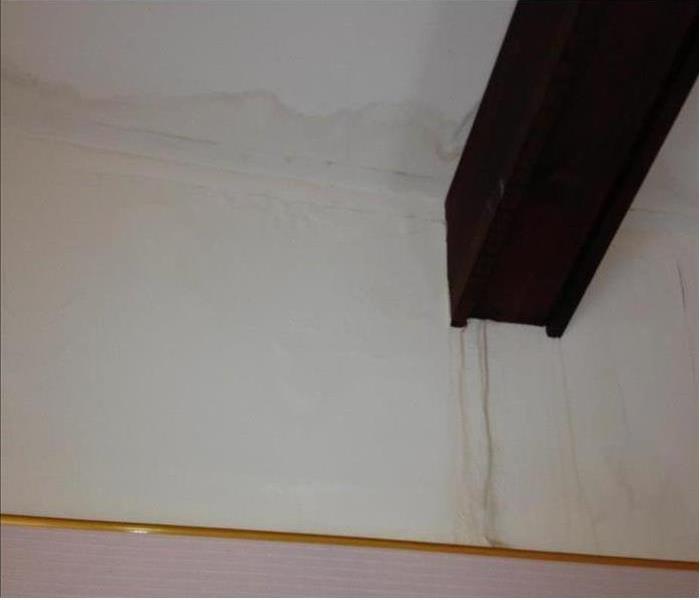 Interior water damage from a clogged gutter.
Interior water damage from a clogged gutter.
Whether due to lack of attention or a freak accident, all homeowners at one point or another experience some type of water issue in their homes. And in many cases, the problems present themselves in subtle ways. The key is to be on the lookout for them so that they don't become a matter that requires a significant amount of time, money, and effort to fix.
With this in mind, the Insurance Institute for Business and Home Safety (IBHS) chronicled the five leading causes of water damage based on property insurance claims. In addition, they outlined the potential indicators of a problem and tips on how homeowners can solve them.
1. PLUMBING SUPPLY SYSTEM FAILURE
The average cost of a plumbing supply system failure was more than $5,000 after the insurance deductible was paid, according to the IBHS study.
Ways to Reduce Damage
- Potential indicators of a plumbing problem include an increased monthly water bill, banging pipes, rust stains, and moisture in the walls or on floors, and signs of wet soil erosion near the foundation.
- Setting the thermostat 60 degrees or higher in winter months, letting faucets drip and insulating pipes are all ways to reduce the risk of frozen pipes.
- Consider installing water alarms or a whole-house automatic water shutoff system
2. TOILET FAILURE
Toilet failures in the IBHS study cost more than $5,500 per incident after the deductible was paid. One-third of all toilet failures in the study resulted from an overflowing or clogged toilet.
Ways to Reduce Damage
- After you flush, wait for the valve to completely finish refilling the tank and bowl. If an overflow looks imminent, turn off the supply valve.
- Twice a year, inspect a toilet’s components, such as the fill, supply and flush valves and the supply line.
- Consider upgrading the toilet’s supply line to a sturdier braided steel hose.
3. WATER HEATER FAILURE
The most common causes of water heater failures in the IBHS study were a slow leak or a sudden burst in the tank, followed by supply line failures. The average cost per incident was $4,444.
Ways to Reduce Damage
- Check the life expectancy and warranty for the water heater and replace accordingly.
- Proper maintenance, such as flushing sediments and inspecting the heater’s anode rod, can increase life expectancy.
- Inspect valves to ensure proper operations, and use ball valves in place of gate valves whenever possible.
4. PLUMBING DRAIN SYSTEM FAILURE
The IBHS study found more than half of plumbing system failures were the result of sewer backups. The problem was more common in southern states and on average cost $4,000 per incident after the insurance deductible was paid.
Ways to Reduce Damage
- If the home’s sewer system is connected to the city’s sewer system – a particular problem for older homes – or if you are located downhill or below street level, contact a plumbing professional to install a backflow prevention assembly into the home’s sewer system.
- Plant trees away from lateral drain lines to prevent roots from damaging piping.
- Never pour grease down the drain.
5. WASHING MACHINE FAILURE
More than half of the claims in the IBHS study were linked to washing machine hose failures. Washing machine claims in the study averaged more than $5,300 per incident after the deductible was paid.
Ways to Reduce Damage
- One burst inlet hose, and your laundry room is flooded in a matter of minutes. Replace rubber hoses every three years and consider upgrading to sturdier braided steel hoses.
- When leaving the house for an extended period of time, turn off the hot and cold water supply valve to reduce failure risks.
Nothing can completely prevent water damage incidents. But you can reduce your risk by taking some precautions.
Protect yourself against water damage from Air Conditioning
1/2/2018 (Permalink)
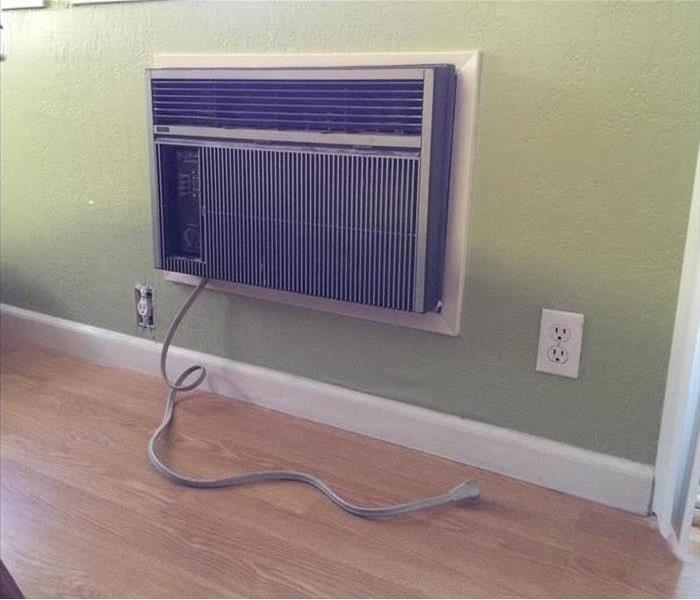 Leaking air conditioner causing water damage to wall and floors
Leaking air conditioner causing water damage to wall and floors
Troubleshooting tips for your air conditioning system:
Evaluate your HVAC system’s air filter. If the filter is dirty or full, the system may not be able to function properly. A dirty air filter can restrict airflow. If the air coming out of your vents seems weak, start with a new air filter. If a clean air filter does not solve the problem, a service call might be in order.
Verify that the outdoor air conditioner unit is not covered in dirt or debris. Any type of dirt or debris that restricts the unit’s airflow can cause it to not function properly. If there is yard debris around the unit, make sure to clear it away.
Check to make sure your thermostat is set properly. At the beginning of the air conditioning season, it can be difficult to remember that your thermostat must be switched to the correct mode. If your thermostat is set incorrectly, your air conditioner will not turn on.
Schedule a tune up and maintenance appointment for your air conditioner. It’s a smart idea to have your air conditioning system tune up at least once a year. During the tune up, the system should be cleaned, lubricated and checked for any problems.
When in doubt, call your air conditioning repair company for a service call. If your air conditioning system does not seem to be working properly, make sure to call a repair company as soon as possible. Air conditioning repair companies can get very busy when the weather gets hot.
Our company handles air conditioning water damage on a routine basis during summer months. If you suspect your air conditioning system has caused water damage, please contact SERVPRO of SW San Jose for a free evaluation.
Small leak in Milpitas, Ca = Big $$
9/21/2017 (Permalink)
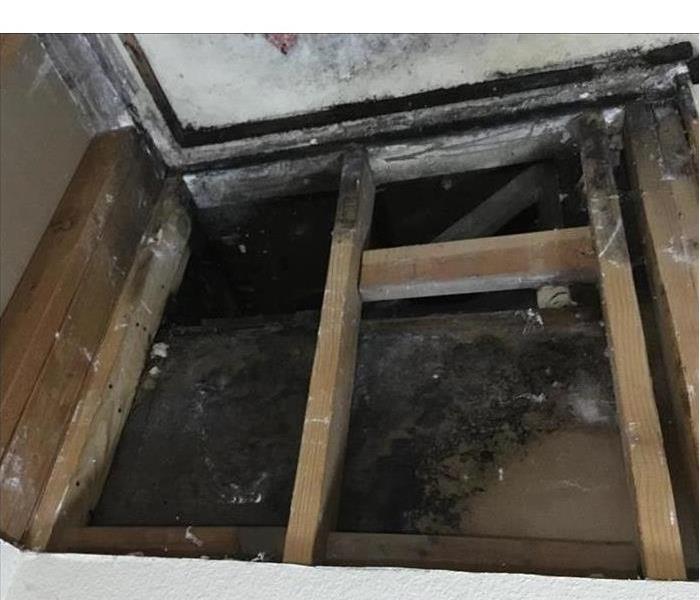 A large amount of mold grows inside this wall cavity
A large amount of mold grows inside this wall cavity
Unfortunately for this customer in Milpitas, Ca they let a water leak go for too long. When they called SERVPRO of SW San Jose they told them they knew they had a chip in their tile grout around the bathtub but didn't fill it.
They ignored the problem and water continued to drip into the cavity.
About a year later the called SERVPRO of SW San Jose, because their wall in their adjacent hallway was bowing and showed discoloration. We performed a complementary inspection and detected water inside the wall using a moisture meter.
Once we opened the wall we found out the total extent of their damage. What could have been fixed with a tube of sealant will now cost thousands to repair.
Ever wonder how we clean up water damage?
5/30/2017 (Permalink)
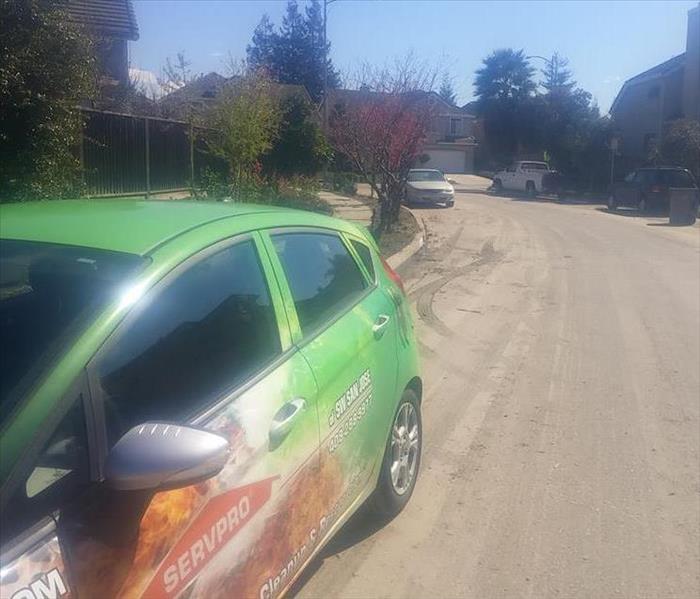 Investigating water damage after the Coyote Creek downtown San Jose flood
Investigating water damage after the Coyote Creek downtown San Jose flood
Ever wonder what the steps are in handling water damage in a building? Check out our video at https://youtu.be/f0ECT3JFr2g for a minute-long crash course!
In the video we begin with our initial survey of the water damaged property, in the case a single family home. A water supply line in the kitchen burst while the family was away on vacation causing large amounts of water damage to the flooring.
After the inspection we come up with a drying strategy that will dry your property as fast as possible with as little demo as possible.
Once the demo and dryout are finished, you don't have to hunt for a new contractor, let us perform your repairs. We value every client we work with, let us help you with your loss from beginning to end.
San Jose Brookwood Neighborhood Flood
2/23/2017 (Permalink)
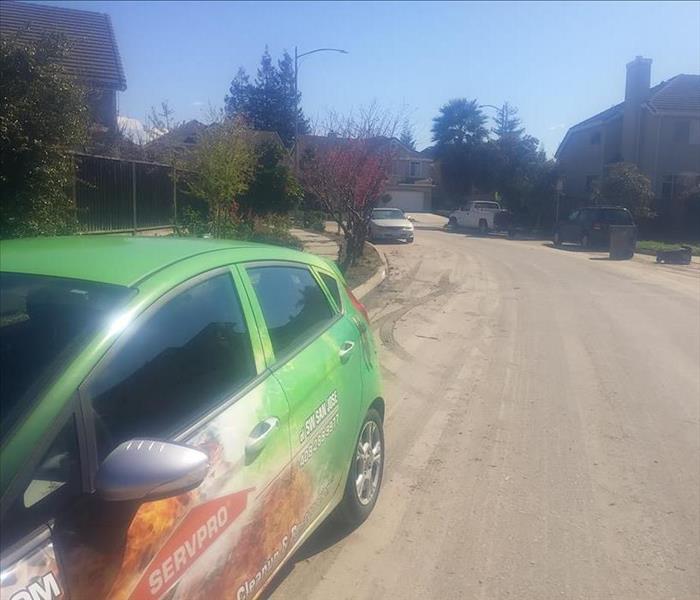 Muddy debris still remains on the streets on Woodvale Ct in downtown San Jose.
Muddy debris still remains on the streets on Woodvale Ct in downtown San Jose.
Out assessing damage in the Brookwood neighborhood of downtown San Jose today near 20th and E Williams Street. This area of the city experienced heavy flooding from Coyote Creek.
Even though Brookwood was built to be above the century high water mark, this flood surpassed this level.
Many residents are dealing with flooded crawlspaces, surface water intrusions, and roof leaks.
Flooding also affected the William Street Park area of San Jose. In the city, floodwaters submerged some residents’ cars and homes, and forced evacuations. And officials have warned residents of dangerously polluted floodwaters.
Floodwaters along Coyote Creek have continued to recede, but about 3,800 San Jose residents were still affected by mandatory evacuations early Thursday, according to officials.
If you have experienced damage related to the flood, we are here to help, give us a call at 408-288-9977.
Hardwood Floor Darkening Mystery
10/25/2016 (Permalink)
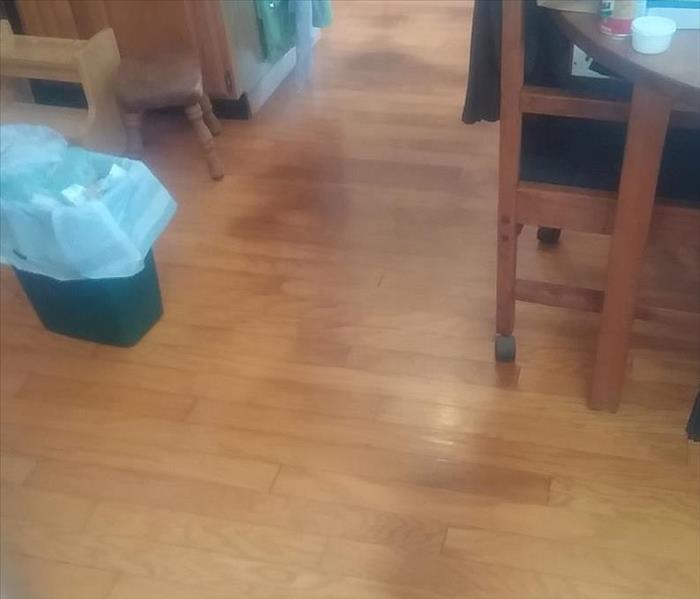 Stain darkening on kitchen hardwood floor
Stain darkening on kitchen hardwood floor
This week a customer telephoned us to report that her kitchen hardwood has been gradually discoloring over several months, in particular over a high traffic area. They were at a loss as to what was causing the discoloration. They contacted their insurance agent and he suggested to call us for a no-obligation inspection.
We sent out a technician who performed a moisture mapping of their floor. He determined not only was there water present under the floor, but also under the carpeting of the family room that is located adjacent to the kitchen.
Our tech carefully peeled back the carpeting to discover a crack in the customer's concrete foundation where water was emanating from.
No customer ever wants to hear the news there is a crack in their foundation - but boy was she relieved to finally know the cause!
Broken Refrigerator Water Supply Line
8/26/2016 (Permalink)
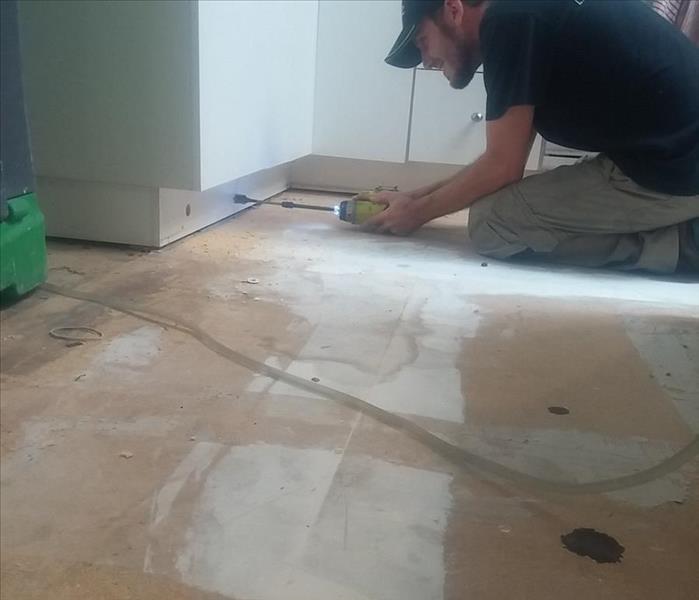 Our technician Jeremy drills holes for cavity drying
Our technician Jeremy drills holes for cavity drying
This week one of our customers is dealing with one of our top 5 worst offenders when it comes to causes of water damage. Most new refrigerators come with plastic water supply lines that hook up to the wall. We highly encourage everyone to replace this line with a copper one that can be purchased at any hardware store such as Home Depot or Lowe's.
Often there is no warning that damage is happening until the flooring begins buckling or walls become soft. Luckily in this case we were able to catch the damage early. It was necessary to remove the floating laminate floor drill holes in the cabinet toe-kicks to allow for air circulation under the cabinets.
After we are finished with the drying we apply an anti-microbial agent to discourage mold growth.
Leaking Drain Line Inside Wall
8/11/2016 (Permalink)
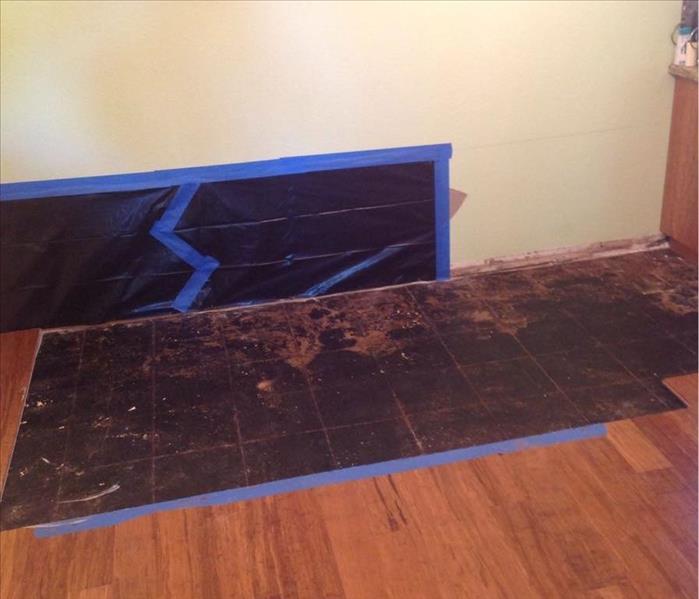 Leak from drain pipe inside wall cavity - cavity and floor water damage
Leak from drain pipe inside wall cavity - cavity and floor water damage
We received a call last week from a customer who was noticiing some discoloration in his wall. He wasn't sure if it was water damage and requested an inspection.
Primarily we use non-intrusive moisture meters to detect water damage. The advantage of this type of moisture meter is that it does not physically damage the materials that it is testing. This is compared to some moisture meters that use metal probes that pierce the object being tested.
Our inspection revealed that not only was his wall cavity affected, but a fair sized amount of flooring. Look in the photo how we found another layer of tile below the floating floor. Customers are often surprised to find one, two, or sometimes even three old floors under a laminate floor.
Your property is our priority
8/3/2016 (Permalink)
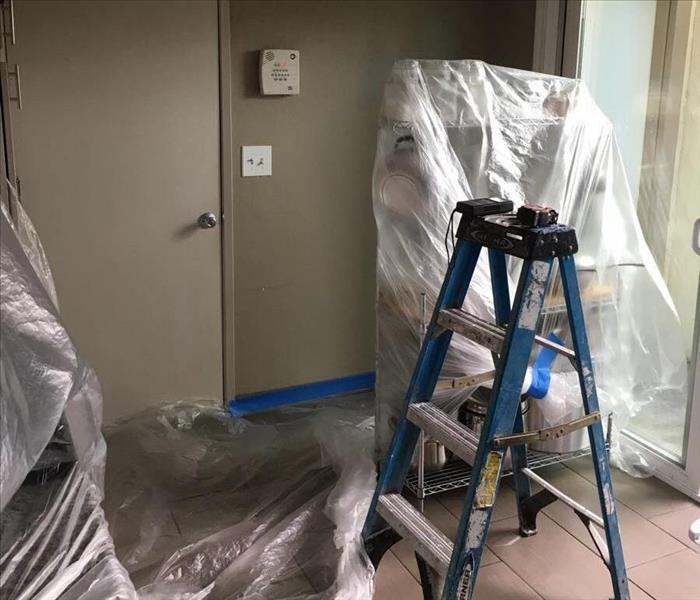 Contents & structure protection
Contents & structure protection
Here at SERVPRO of SW San Jose we treat your belongings with concern and care. During our work we take measures to minimize the impact to unaffected property.
In this case, water was leaking from the bathroom above and it was necessary to demolish part of the ceiling. In order to protect the structure and contents of the room to be demolished, we typically use 6 mil plastic.
Demolition can be a messy business. When considering a contractor, ask them specifically what measures they will take to protect the rest of your home while they are at work. If reconstruction is needed, we at SERVPRO of SW San Jose can provide post-construction cleanup assistance. Whether or not we help you with your repairs, you can count on us to make it "Like It Never Even Happened".
What a mess - refrigerator water line leak
5/27/2016 (Permalink)
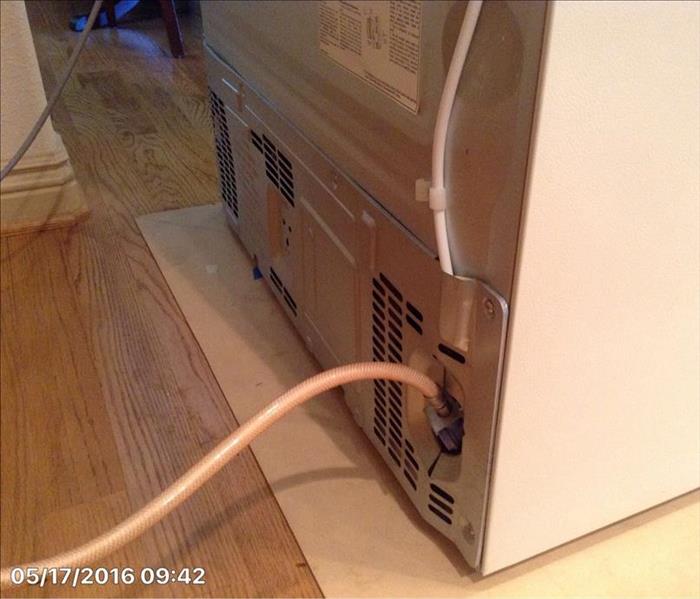 Replace your refrigerator supply line every 5 years
Replace your refrigerator supply line every 5 years
This week we helped one of our customers who discovered their refrigerator water line had been leaking for months without their knowledge. By the time they discovered it, their floor was coming up and their sheetrock was drenched!
El Nino 2015 -- Are you prepared?
10/29/2015 (Permalink)
 Image: This image by the (NOAA) compares the warm Pacific waters of the El Niño 1997-98 event with conditions this summer.
Image: This image by the (NOAA) compares the warm Pacific waters of the El Niño 1997-98 event with conditions this summer.
You may have heard on the news that the El Nino is strong this year, but how strong? The article below is a quick read but provides useful tips on how everyone should prepare for this winter. - Dave K
WHAT YOU SHOULD DO NOW TO PREPARE FOR EL NINO
Statewide, 17 people died.
Big waves and mudslides alike washed away roads and indiscriminately submerged Malibu mansions and hillside apartments buildings.
Rivers overflowed, seven inches of rain fell in a single day, and the damage cost California more than $400 million. It was California’s wettest winter on record. It was the El Niño 1997-98.
While climate models hint that the coming El Niño can rival or surpass the 1997-98 El Niño, most experts admit the weather phenomenon is as truly temperamental as a toddler. The coming rainfall may be unpredictable, but one thing is not: a decade of drought and catastrophic wildfires have left the parched landscape as ill-prepared for torrential rain as it is in need of it.
Experts at FEMA say now is the time to prepare for El Niño.
“Flooding is the most expensive natural disaster in the United States,” said Olivia Humilde, FEMA’s Mitigation Outreach Specialist. “We all know that mother nature will do her thing, and you can’t really control it.”
But you can prepare for it.
The first step, says Humilde, is to know your risk. Residents living in low-lying beachfront homes such as those in Seal Beach are aware of their flood risks, but folks living in drought-stricken or fire-ravaged canyons may not be aware that conditions are uniquely aligned for mudslides.
“If you are in a wildfire area and the area around you has burned, the land can’t absorb that water,” Humilde said.
Residents can identify their flood risk by entering their addresses at the government’s floodsmart website.
Most homeowners’ insurance policies don’t cover flooding. If you think your home is at risk of flooding this winter, now is the time to buy flood insurance, said Humilde. Policies take 30 days to go into effect, she added. Policies that cover building and contents cost less than $500 a year, she said. The floodsmart website includes information about flood insurance and links to insurance agents.
Even more important than insuring your home is preparing your family for an emergency.
Humilde advises families to put together a disaster supply kit and to practice a family communication plan. A basic disaster supply kit, should include a clear gallon tub filled with:
a battery powered hand crank radio to listen to evacuation routes,a flashlight,batteries,a first aid kit,a whistle,water,canned food and can opener,a cell phone with external chargers or solar powered chargers from stores such as REI, prescription medications,eye glasses,formula and diapers for babies,and pet food and water for animalsA family communication plan should prepare everyone in the family for the possibility of an emergency during the day when children may be at school or parents at work. Families should designate a first point of contact to check in with and a place to evacuate to. Social media can be a very efficient way to communicate with one another, said Humilde. A communication plan could include an emergency family twitter hashtag.
“An emergency is stressful enough,” said Humilde. “Knowing you have plan in place is really helpful.”
Article by Paige Austin, Los Alamitos-Seal Beach Patch
Is your water mitigation provider IICRC Certified?
7/27/2015 (Permalink)
Who should you call after you suffer a water damage? Do you go with who your insurance company recommends? How about your neighbor?
Make sure whoever you hire is holds their water damage certification from the Institute of Inspection, Cleaning, and Restoration Certification (IICRC).
SERVPRO of SW San Jose proudly holds certification from the IICRC.
IICRC Certified Firms have earned the right to display the IICRC logo as a symbol of quality. In order to achieve IICRC-certified status, firms must meet a rigorous list of standards in business ethics and expertise. All IICRC Certified Firms must:
- Present accurate information to consumers and conduct business with honesty and integrity.
- Require a technician on all jobs who has been formally trained and passed all required tests.
- Require a continuing education program to keep technicians up-to-date on the latest changes in the industry.
- Maintain liability insurance to protect all parties in the event of an accident.
- Maintain a written complaint policy and agree to Better Business Bureau or similar arbitration to resolve disputes, and accept the conclusions and recommendations of arbitration.
The IICRC actively has relationships with fiber producers, carpet and fabric mills, furnishing manufacturers and retailers, and others affiliated with the industry. The use of IICRC service professionals is specified in leading manufacturers’ maintenance brochures and warranties.
When it comes to cleaning, restoration and inspection, the IICRC writes the books
As an ANSI-accredited Standards Developing Organization (SDO), the IICRC has led the way in establishing the main industry standards and reference guides for professional carpet cleaning, upholstery and fabric cleaning, water damage restoration and mold remediation.
Each IICRC standard takes years to develop and the coordination of several experts in the field, including allied tradespersons; manufacturers; international, national and regional trade associations; individual or franchise professionals; cleaning, inspection and restoration industry organizations; insurance industry; training schools; contractors; and public health professionals.
These standards are reviewed and updated at least every five years. Many of these fields, such as the water damage restoration field, change rapidly and those who are certified keep up with the advancement of the science and generally accepted practices of the industry.
The IICRC helps keep homes and businesses healthful
According to the Environmental Protection Agency, the average person spends 90 percent or more of their time indoors, where levels of pollutants may be two to five times (and occasionally more than 100 times) higher than outdoor levels.
This makes it extremely important to perform regular maintenance inside your home or business. In addition to vacuuming, cleaning and checking for water damage on a regular basis, using a certified technician for cleaning will help extend the life of your flooring and upholstery and ensure that your home or business is healthful for those who live and work there.
IICRC Benefit
The IICRC is a nonprofit certification and Standards Developing Organization (SDO) for the inspection, cleaning and restoration industries. Serving the United States, Canada, United Kingdom, Australia, New Zealand and Japan, in partnership with regional and international trade associations, the IICRC represents the entire industry. The IICRC is recognized internationally as a knowledgeable industry voice and resource.
http://www.iicrc.org/iicrc-benefit/for-consumers/
How can I prevent water damage in my home?
6/3/2015 (Permalink)
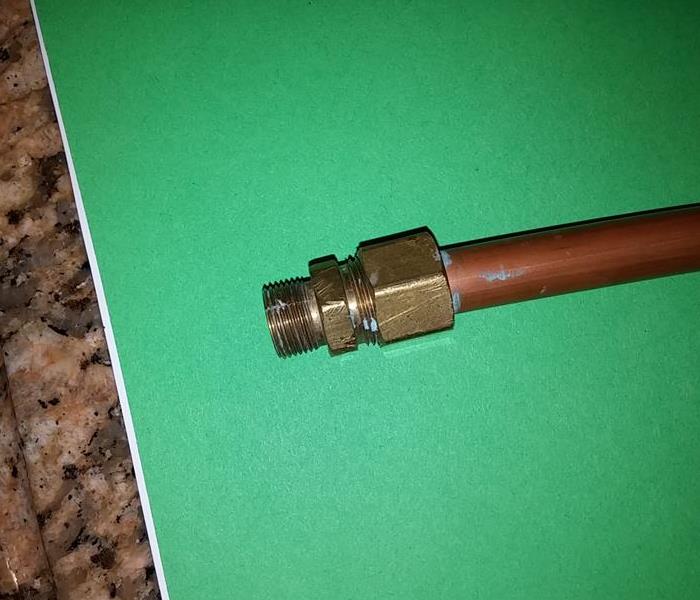 Cracked Water Supply Line
Cracked Water Supply Line
Want to learn more about how to prevent water damage in your home? What are the most common causes of water losses? Listen to our May radio interview on the Your Homes Today radio program on KLIV AM 1590!
http://media.kliv.com/p/2015_05_16_YourHomesToday.mp3
Week 5 Question - Scavenger Hunt Contest Fall 2014
11/3/2014 (Permalink)
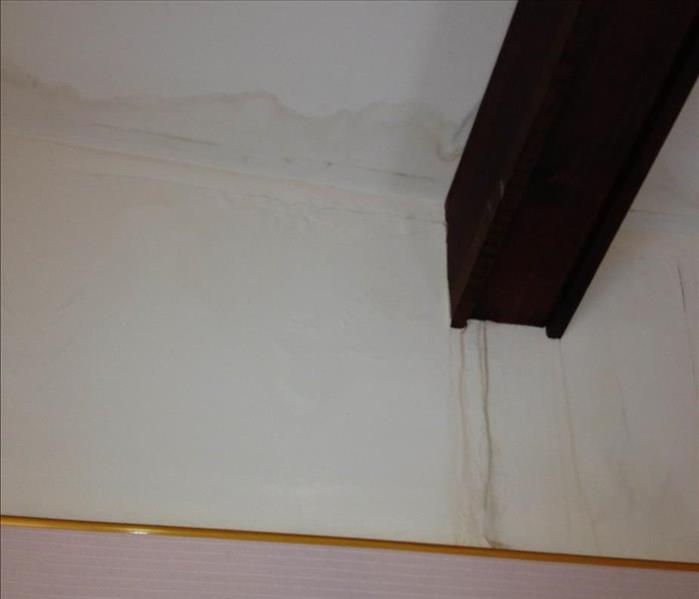 Interior water damage from a clogged gutter
Interior water damage from a clogged gutter
Whether due to lack of attention or a freak accident, all homeowners at one point or another experience some type of water issue in their homes. And in many cases, the problems present themselves in subtle ways. The key is to be on the lookout for them so that they don't become a matter that requires a significant amount of time, money, and effort to fix.
With this in mind, the Insurance Institute for Business and Home Safety (IBHS) chronicled the five leading causes of water damage based on property insurance claims. In addition, they outlined the potential indicators of a problem and tips on how homeowners can solve them.
1. PLUMBING SUPPLY SYSTEM FAILURE
The average cost of a plumbing supply system failure was more than $5,000 after the insurance deductible was paid, according to the IBHS study.
Ways to Reduce Damage
Potential indicators of a plumbing problem include an increased monthly water bill, banging pipes, rust stains, and moisture in the walls or on floors, and signs of wet soil erosion near the foundation.Setting the thermostat 60 degrees or higher in winter months, letting faucets drip and insulating pipes are all ways to reduce the risk of frozen pipes.Consider installing water alarms or a whole-house automatic water shutoff system 2. TOILET FAILURE
Toilet failures in the IBHS study cost more than $5,500 per incident after the deductible was paid. One-third of all toilet failures in the study resulted from an overflowing or clogged toilet.
Ways to Reduce Damage
After you flush, wait for the valve to completely finish refilling the tank and bowl. If an overflow looks imminent, turn off the supply valve.Twice a year, inspect a toilet’s components, such as the fill, supply and flush valves and the supply line.Consider upgrading the toilet’s supply line to a sturdier braided steel hose. 3. WATER HEATER FAILURE
The most common causes of water heater failures in the IBHS study were a slow leak or a sudden burst in the tank, followed by supply line failures. The average cost per incident was $4,444.
Ways to Reduce Damage
Check the life expectancy and warranty for the water heater and replace accordingly.Proper maintenance, such as flushing sediments and inspecting the heater’s anode rod, can increase life expectancy.Inspect valves to ensure proper operations, and use ball valves in place of gate valves whenever possible.4. PLUMBING DRAIN SYSTEM FAILURE
The IBHS study found more than half of plumbing system failures were the result of sewer backups. The problem was more common in southern states and on average cost $4,000 per incident after the insurance deductible was paid.
Ways to Reduce Damage
If the home’s sewer system is connected to the city’s sewer system – a particular problem for older homes – or if you are located downhill or below street level, contact a plumbing professional to install a backflow prevention assembly into the home’s sewer system.Plant trees away from lateral drain lines to prevent roots from damaging piping.Never pour grease down the drain.5. WASHING MACHINE FAILURE
More than half of the claims in the IBHS study were linked to washing machine hose failures. Washing machine claims in the study averaged more than $5,300 per incident after the deductible was paid.
Ways to Reduce Damage
One burst inlet hose, and your laundry room is flooded in a matter of minutes. Replace rubber hoses every three years and consider upgrading to sturdier braided steel hoses.When leaving the house for an extended period of time, turn off the hot and cold water supply valve to reduce failure risks.Nothing can completely prevent water damage incidents. But you can reduce your risk by taking some precautions.
Week 3 Question - Scavenger Hunt Contest Fall 2014
10/20/2014 (Permalink)
A mother of two young children contacted us because of a mold concern. Here is her story:
“Mold is growing on the sheet rock in my bathroom. I’ve sprayed it down with bleach and cleaning solution a number of times, but it always seems to grow right back”! It measures about 25 sq ft in total. My husband says he can cut out the affected sheet rock and hang new sheet rock, but I’m afraid of he and my children getting sick. What should we do?
According to EPA Guidelines, what type of Containment and Personal Protective Equipment (PPE) are suggested to remediate 25 sq feet of mold?
- No Containment / No PPE needed
- No Containment / Minimum PPE needed
- Limited Containment / Limited PPE - Half-Face Air Purifying Respirator (APR) with HEPA Filter
- Limited Containment / Minimum PPE needed
- Full Containment with Decon Chamber / Full PPE - Full-Face APR with HEPA Filter
Need a hint? "Hunt" below in our mold article!
If you have any trouble answering the question or run into submission problems please contact me. Good luck!
Dave Kraszewski / SERVPROdave@gmail.com -- Email
There is no practical way to eliminate all mold and mold spores in the indoor environment; the way to control indoor mold growth is to control moisture. Molds can be found almost anywhere; they can grow on virtually any substance, providing moisture is present. They can grow on wood, paper, carpet, and foods – this is why when you leave open bread on a counter, it begins to become moldy in a few days. Mold is a part of our everyday environment.
Some people are sensitive to molds. For these people, exposure to molds can cause symptoms such as nasal stuffiness, eye irritation, wheezing, or skin irritation. Some people, such as those with serious allergies to molds, may have more severe reactions. Severe reactions may occur among people exposed to large amounts of molds in occupational settings, such as farmers working around moldy hay. Severe reactions may include fever and shortness of breath. Some people with chronic lung illnesses, such as obstructive lung disease, may develop mold infections in their lungs.
If mold is a problem in your home, you must clean up the mold and eliminate sources of moisture. Fix the source of the water problem or leak to prevent mold growth. Reduce indoor humidity (to 30-60%) to decrease mold growth by: venting bathrooms, dryers, and other moisture-generating sources to the outside; using air conditioners and de-humidifiers; increasing ventilation; and using exhaust fans whenever cooking, dishwashing, and cleaning.
Water in your home can come from many sources. Water can enter your home by leaking or by seeping through floors. Showers or cooking can add moisture to the air in your home. The amount of moisture that the air in your home can hold depends on the temperature of the air. As the temperature goes down, the air is able to hold less moisture. This is why, in cold weather, moisture condenses on cold surfaces (for example, drops of water form on the inside of a window). This moisture can encourage biological pollutants to grow.
When remediating mold, the goal of containment is to limit the spread of mold throughout the building and minimize the exposure to technicians and building occupants. The larger the contaminated area, and the greater the possibility that someone will be exposed to mold, the greater the need for containment. An exception could be heavy mold growth in a small area. It could release more mold spores than lighter growth in a relatively large area. In this case, the smaller moldy area may warrant a higher level of containment.
Two types of containment are described in the EPA's mold remediation guidelines: limited and full. Limited containmentis generally used for areas involving 10 and 100 sq ft of mold contamination. Full containment is used when areas larger than 100 sq ft are to be remediated. Containment for jobs under 10 sq ft usually is not necessary.
Types of Personal Protective Equipment (PPE):
Minimum: Gloves, N-95 respirator, goggles/eye protection. Used for jobs under 10 sq ft.Limited: Gloves, Half-face Air Purifying Respirator (APR) with HEPA filter, disposable overalls, goggles/eye protection. Used for jobs 10-100 sq ft.Full: Gloves, disposable full body clothing, head gear, foot coverings, full-face respirator (APR) with HEPA filter. Used on jobs larger than 100 sq ft. The easiest way to solve mold problems is to prevent mold growth in the first place. Here are some tips to follow:
MOISTURE CONTROL IS KEYKeep the building clean and dry. Dry wet or damp areas within 48 hours.Fix leaky plumbing and leaks in the building envelope as soon as possible.Watch for condensation and wet spots. Fix the sources of moisture problems as soon as possible.Prevent moisture due to condensation by increasing surface temperature or reducing the moisture level in air (humidity). To increase surface temperature, insulate or increase air circulation. To reduce the moisture level in air, repair leaks and increase ventilation (if outside air is cold and dry), or dehumidify (if outdoor air is warm and humid).Keep heating, ventilation, and air conditioning (HVAC) drip pans clean, flowing properly, and unobstructed.Vent moisture generating appliances, such as dryers, to the outside where possible.Maintain low indoor humidity, below 60 percent relative humidity (RH), ideally 30 percent to 50 percent, if possible.Perform regular building and HVAC inspections and maintenance as scheduled.Don't let foundations stay wet. Provide drainage and slope the ground away from the foundation.If you are not experienced with home/building repairs you may want to consult a professional when making repairs, or for assistance with mold-prevention-related changes to your home/building.
Week 1 Question -- Scavenger Hunt Contest Fall 2014
10/1/2014 (Permalink)
You arrive home to find the water line to your refrigerator has ruptured. Your kitchen and living room are flooded and your living room carpet is soaking wet! Which of the following things should you NOT do?
A. Remove excess water by mopping & blotting
B. Leave area rugs in-place on your carpeting
C. Turn on your air-conditioning
D. Place aluminum foil strips under furniture legs in living room
E. Gather loose items up from floors
Need a hint? Check out http://www.servproswsanjose.com/water-damage-tips
Instructions: Click on the correct answer; a pop-up window should open asking to send an email. Hit "Send" to submit your answer. If a window does not appear (because you have a pop-up blocker) - you may email your answer directly to Dave Kraszewski at servprodave@gmail.com.
Answers must be submitted by 11:59PM on 10/12 to be eligible. Limit 1 submission per person per week.
 An office area with various pieces of drying equipment from SERVPRO, including a dehumidifier and air movers, set up to mitigate water damage.
An office area with various pieces of drying equipment from SERVPRO, including a dehumidifier and air movers, set up to mitigate water damage.





 24/7 Emergency Service
24/7 Emergency Service



















